Gross Anatomy Module 4: Osteology and Arthrology of Upper Extremities
1/192
There's no tags or description
Looks like no tags are added yet.
Name | Mastery | Learn | Test | Matching | Spaced |
|---|
No study sessions yet.
193 Terms
Upper extremities anatomical divisions
Shoulder
Arm
Forearm
Hand

Shoulder
-Proximal segment, overlapping the trunk and neck
-Overlies half of the pectoral girdle (bony ring formed by the scapula, clavicle, and manubrium)
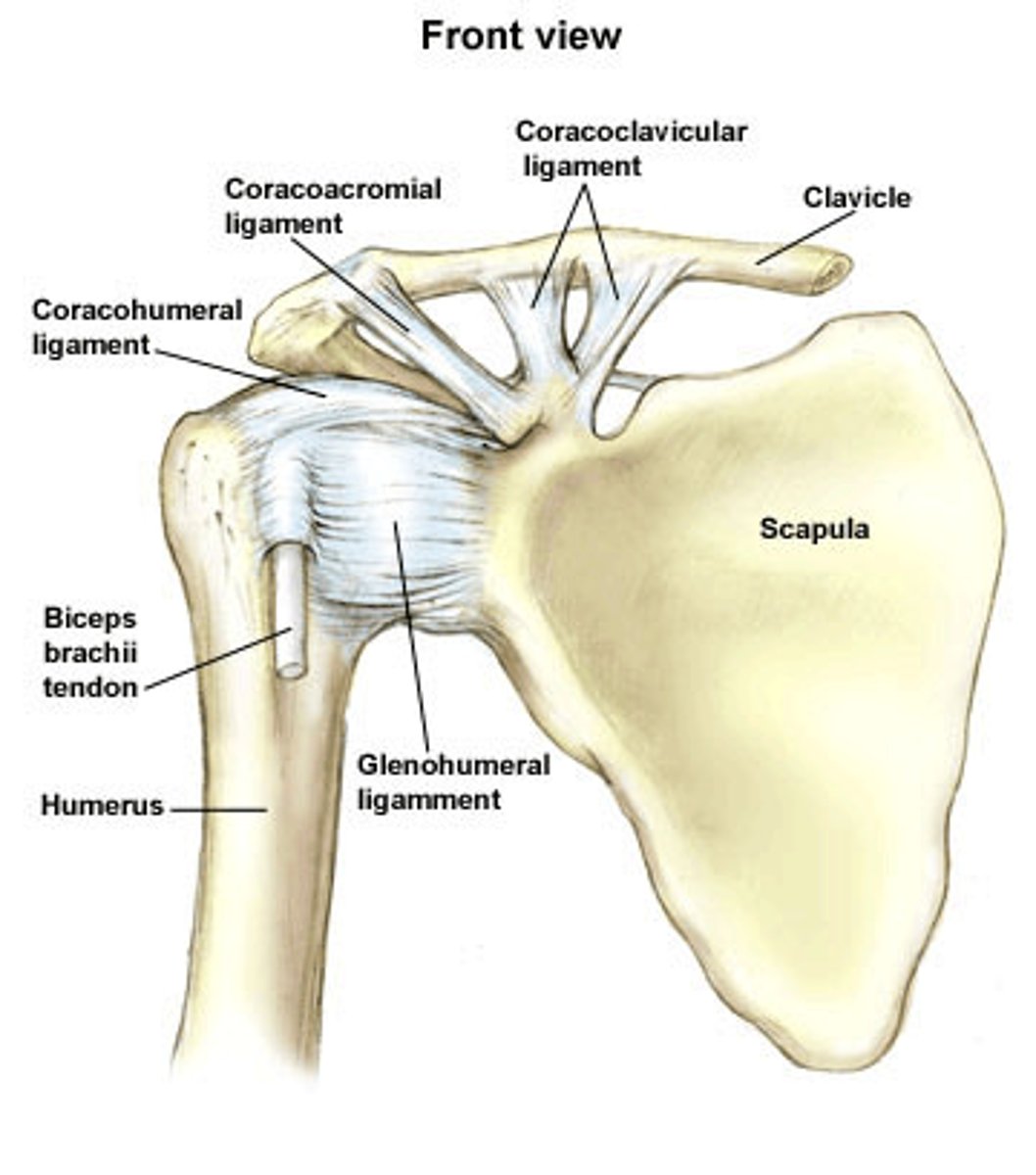
The shoulder overlies
half of the pectoral girdle (bony ring formed by the scapula, clavicle, and manubrium)

Parts of the upper limb included in the shoulder
-Pectoral
-Scapular
-Deltoid
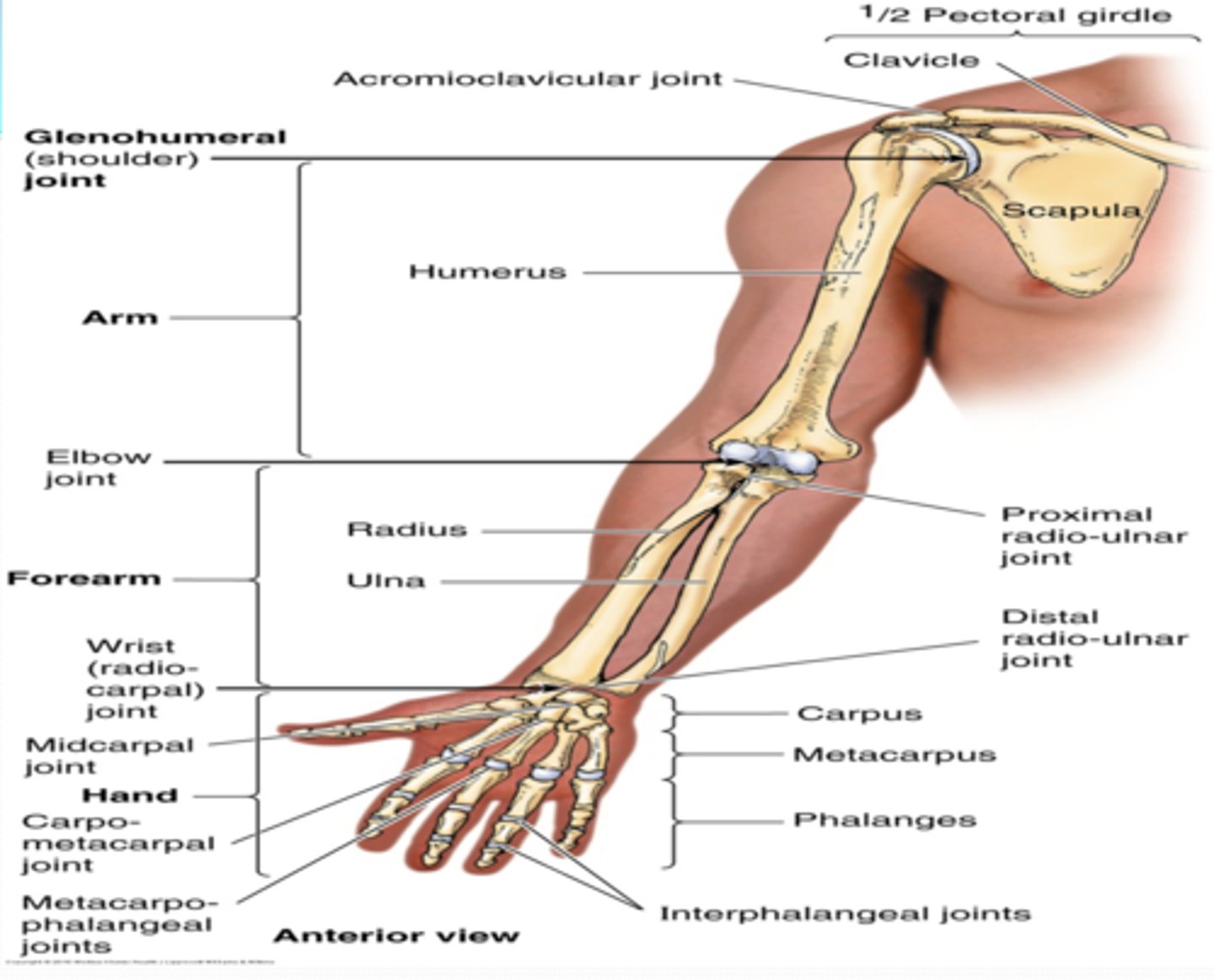
The arm extends
between and connects the shoulder and the elbow
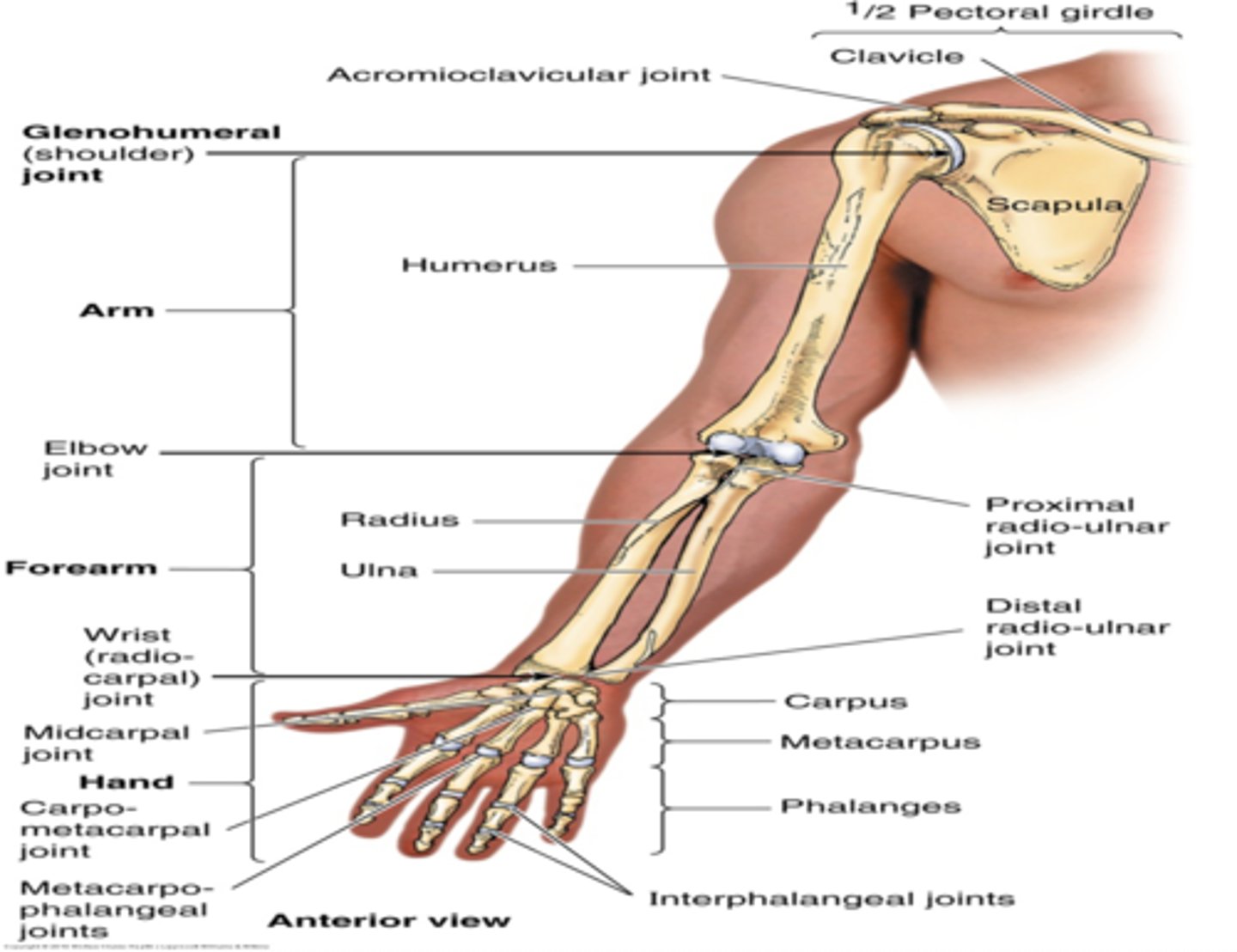
Arm
-1st segment and longest part of the free UL (Upper Limb)
-Extends between and connects the shoulder and the elbow

Parts of the upper limb in the ARM
-Anterior region of arm
-Posterior region of arm
forearm
-2nd segment and second longest portion of the UL
-Extends between and connects the elbow and the wrist
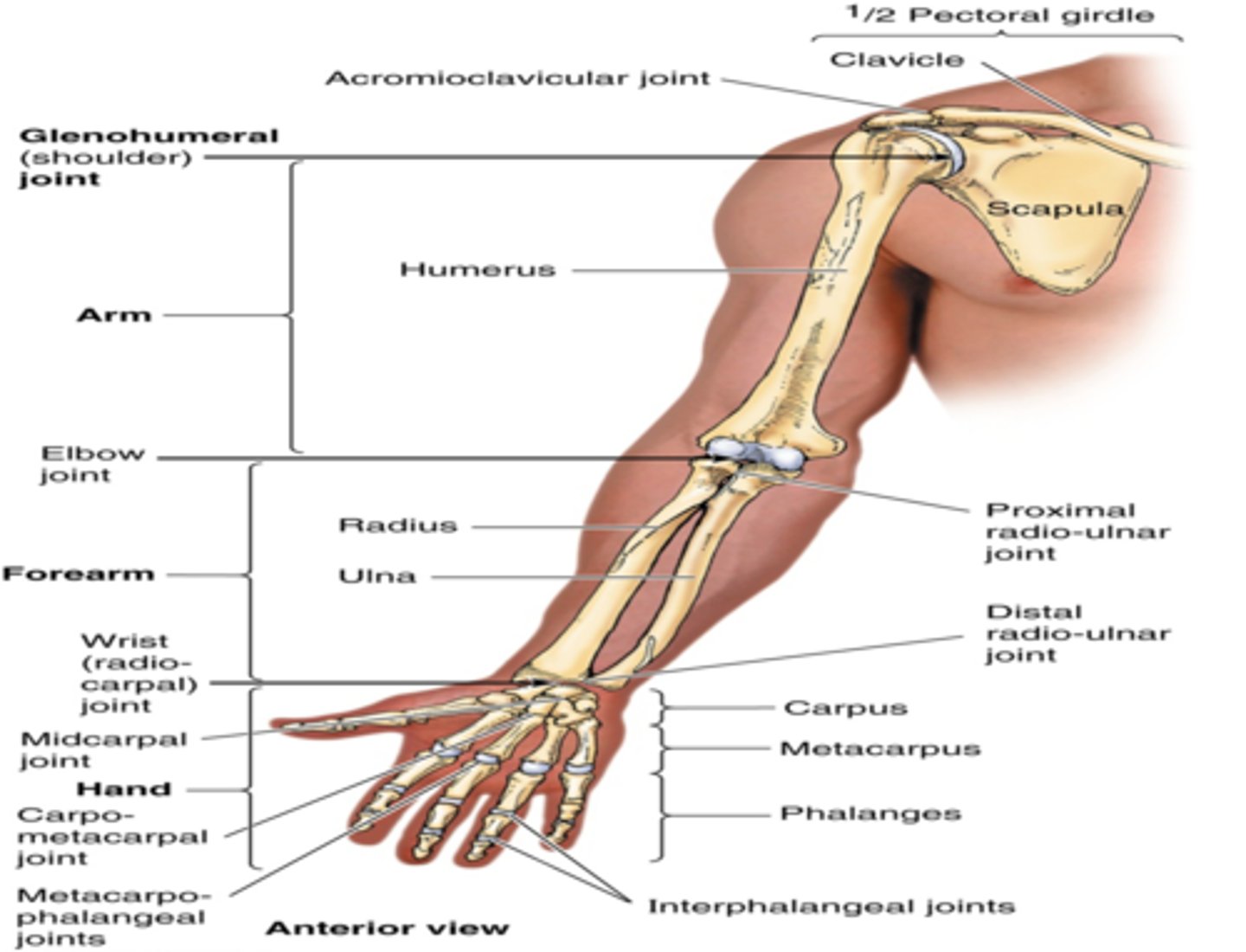
The forearm extends
between and connects the elbow and the wrist
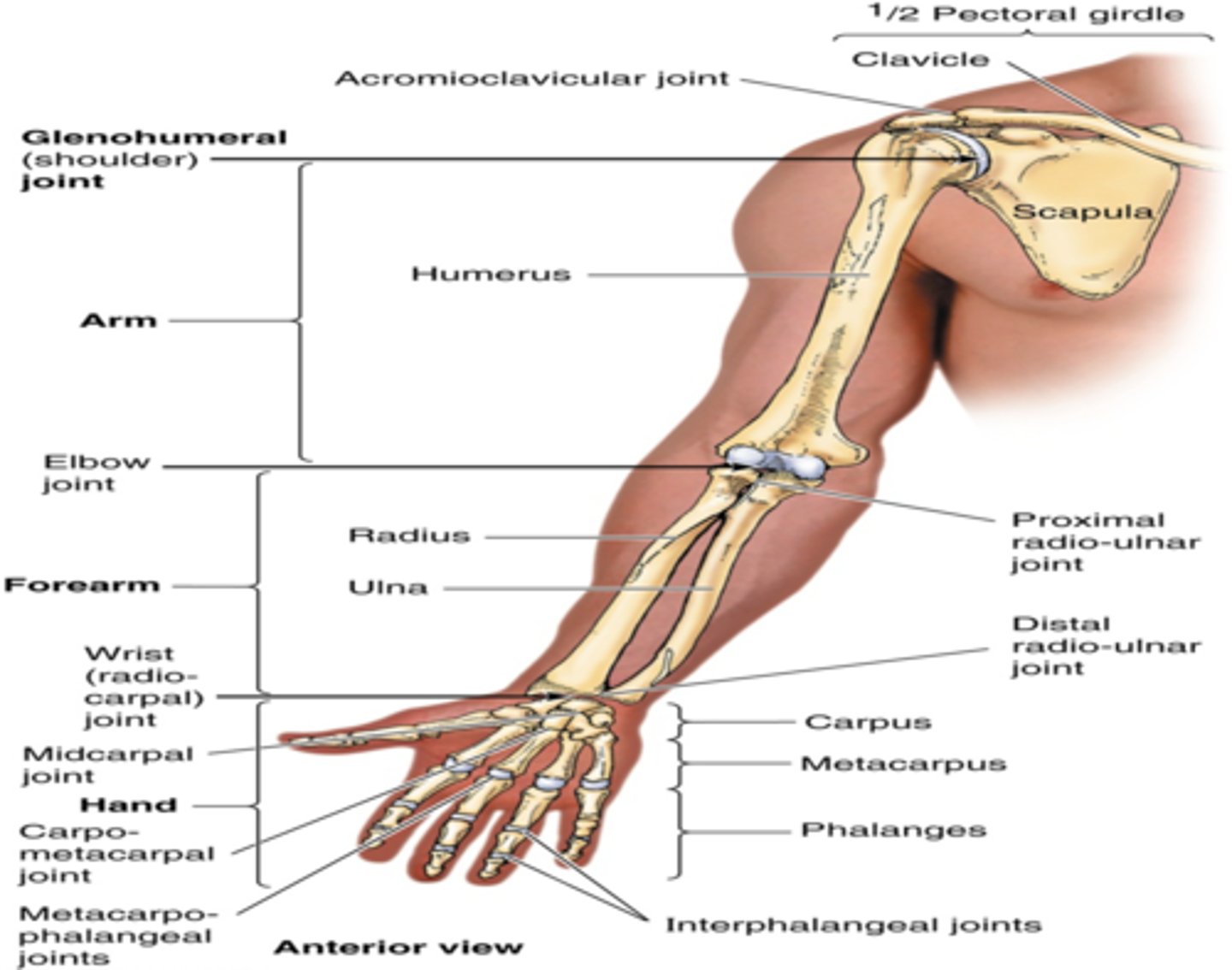
Parts of the upper limb in the Forearm
-Anterior region of forearm
-Posterior region of forearm
Hand
-Most distal segment of the UL
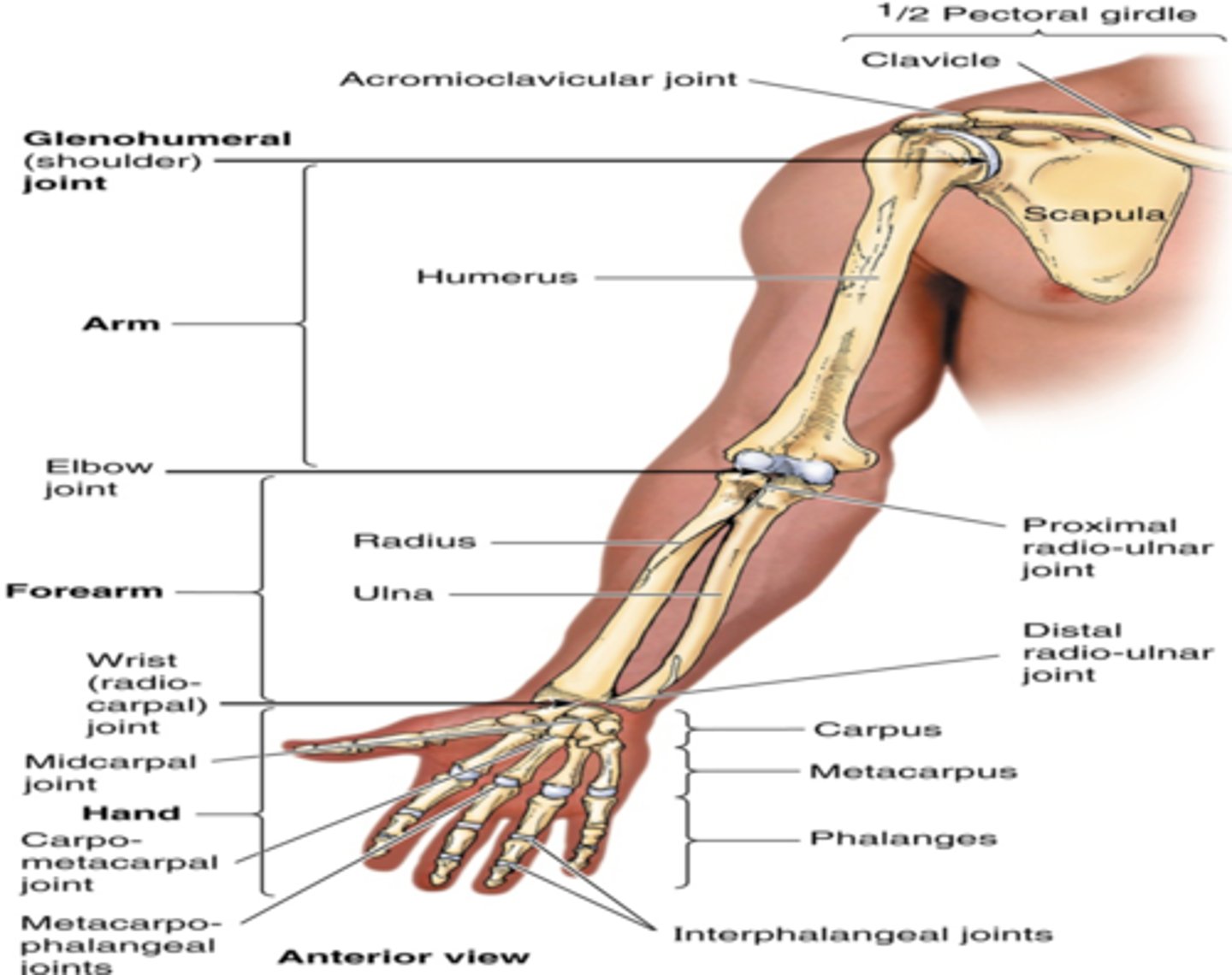
Clavicle connects the upper extremity
to the trunk

Clavicle
•Connects the UE to the trunk
•Suspends the scapula and free limb from the trunk
•Forms one of the boundaries of the cervico-axillary canal (passage between neck and arm) together with the scapula and 1st rib. This canal protects the neurovascular bundle supplying the arm
•Transmits shocks from the UE to the axial skeleton
Parts of the Upper Limb in the Hand
-Wrist
-Palm
-Dorsum of hand
-Digits
What does the clavicle suspend?
the scapula and free limb from the trunk
What boundaries does the clavicle form?
one of the boundaries of the cervico-axillary canal (passage between neck and arm) together with the scapula and 1st rib. This canal protects the neurovascular bundle supplying the arm
The clavicle transmits force from the ___________ to the ___________.
shocks from the upper limb to the axial skeleton
What are the parts of the clavicle?
-Shaft
-Superior surface
-Inferior surface
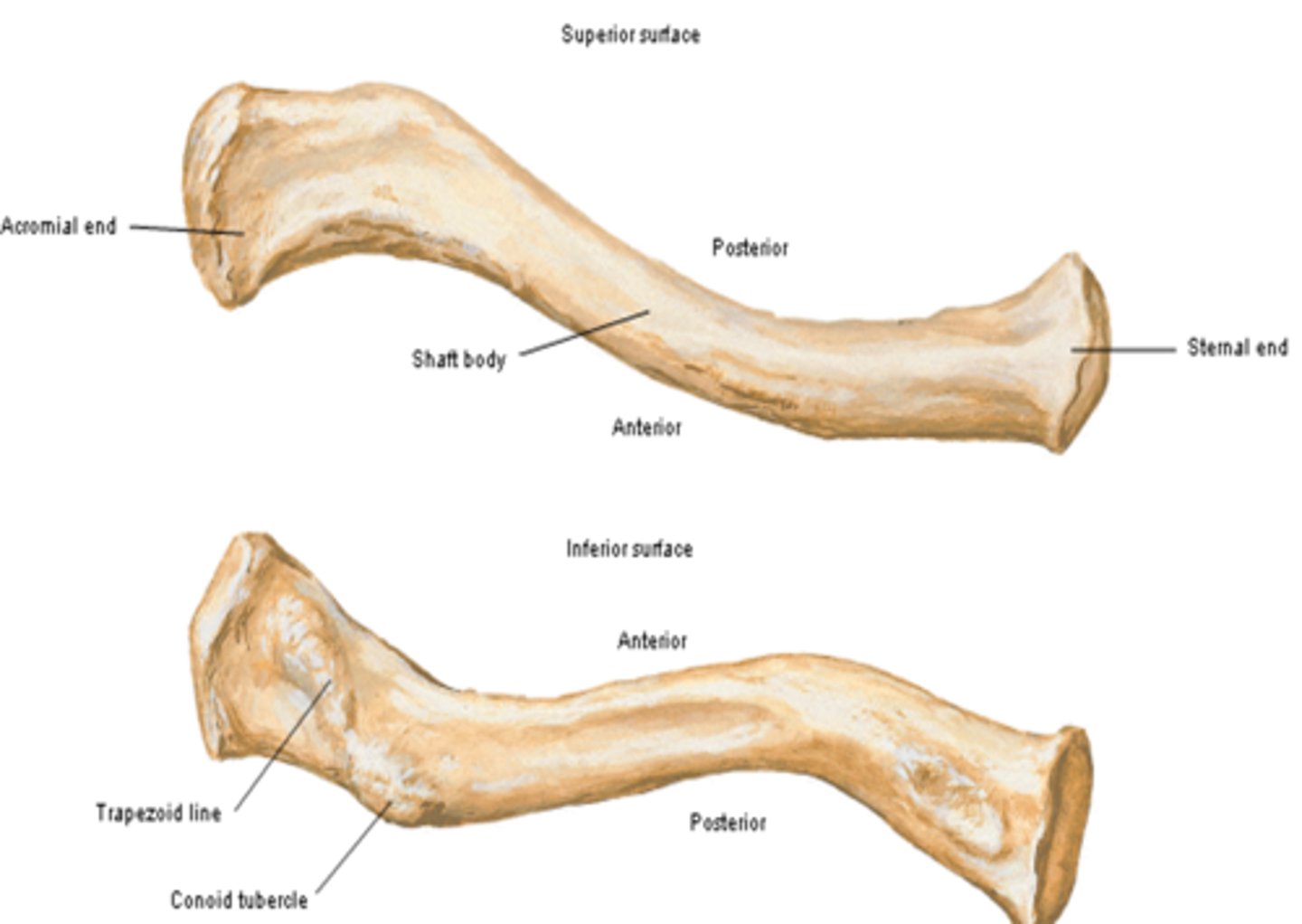
shaft of clavicle is ...
double-curved in the horizontal plane, which increases resilience
-Median Half, sternal end, acromial end

Shaft of clavicle: Median Half is...
is convex anteriorly, and lateral half concave anteriorly

Shaft of clavicle: Sternal End articulates with?
articulates with manubrium (sternoclavicular joint)
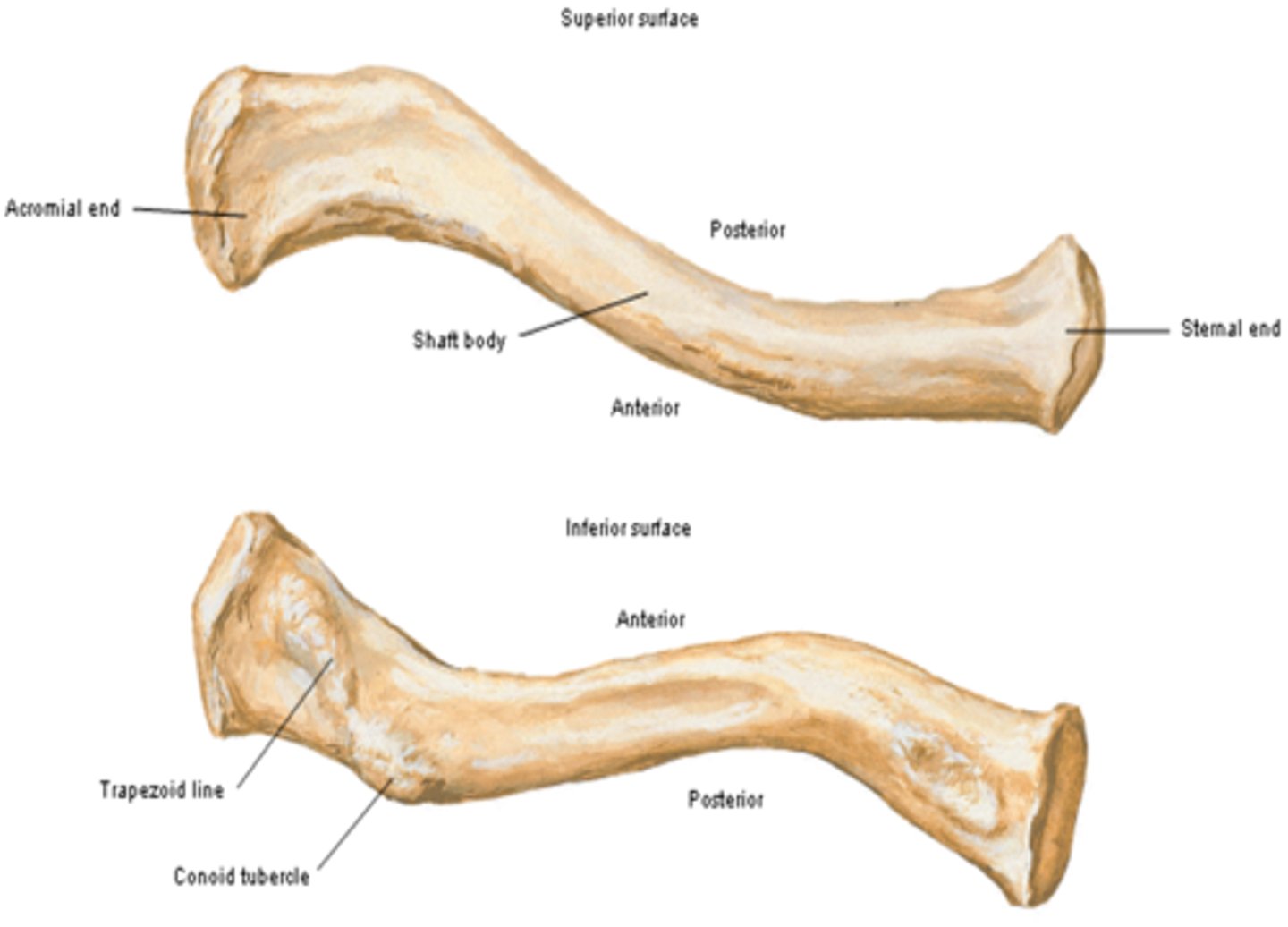
Shaft of clavicle: Acromial End atriculates with?
articulates with acromion (acromioclavicular joint)
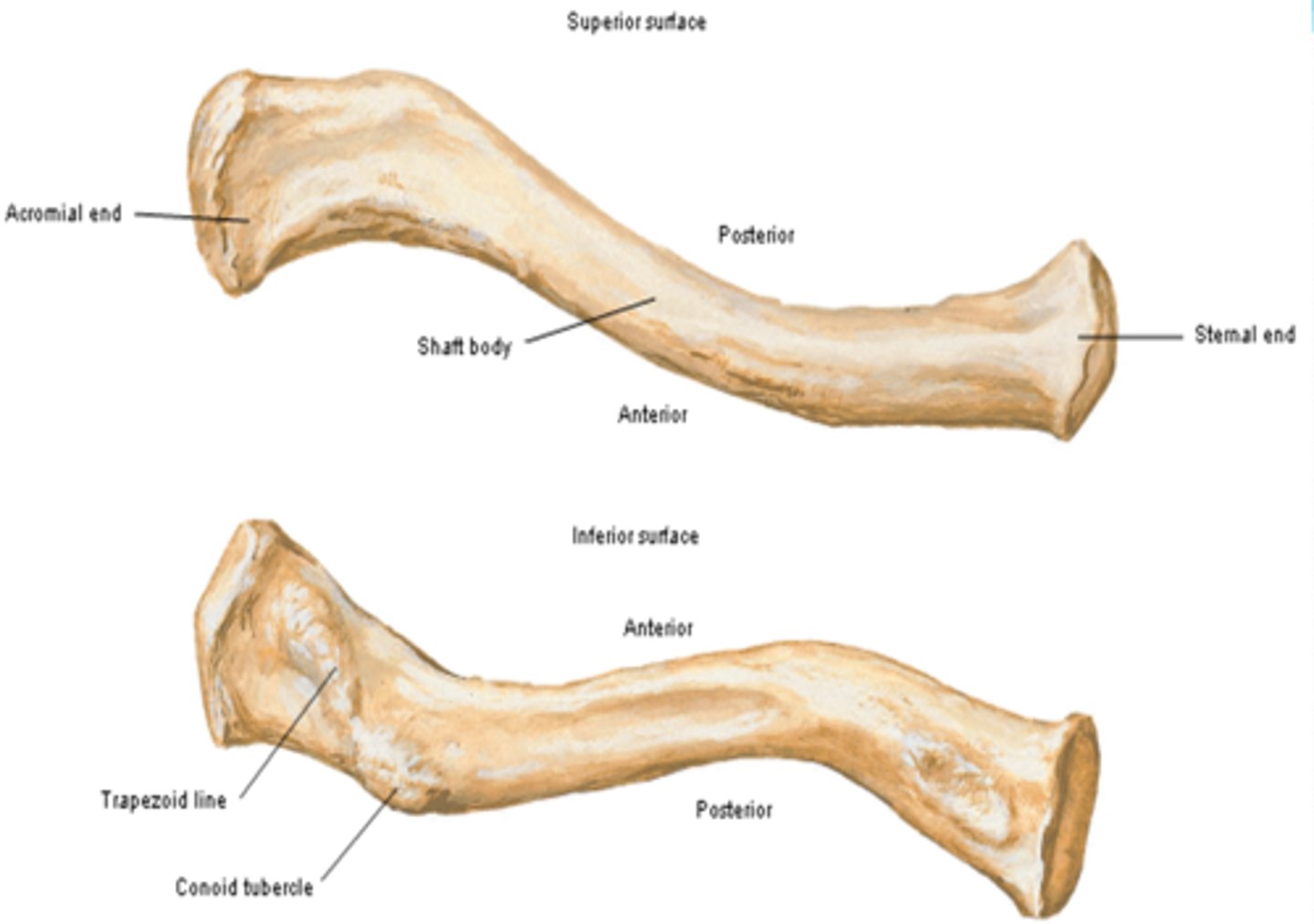
superior surface of clavicle
lies deep to the platysma muscle and skin and it is smooth
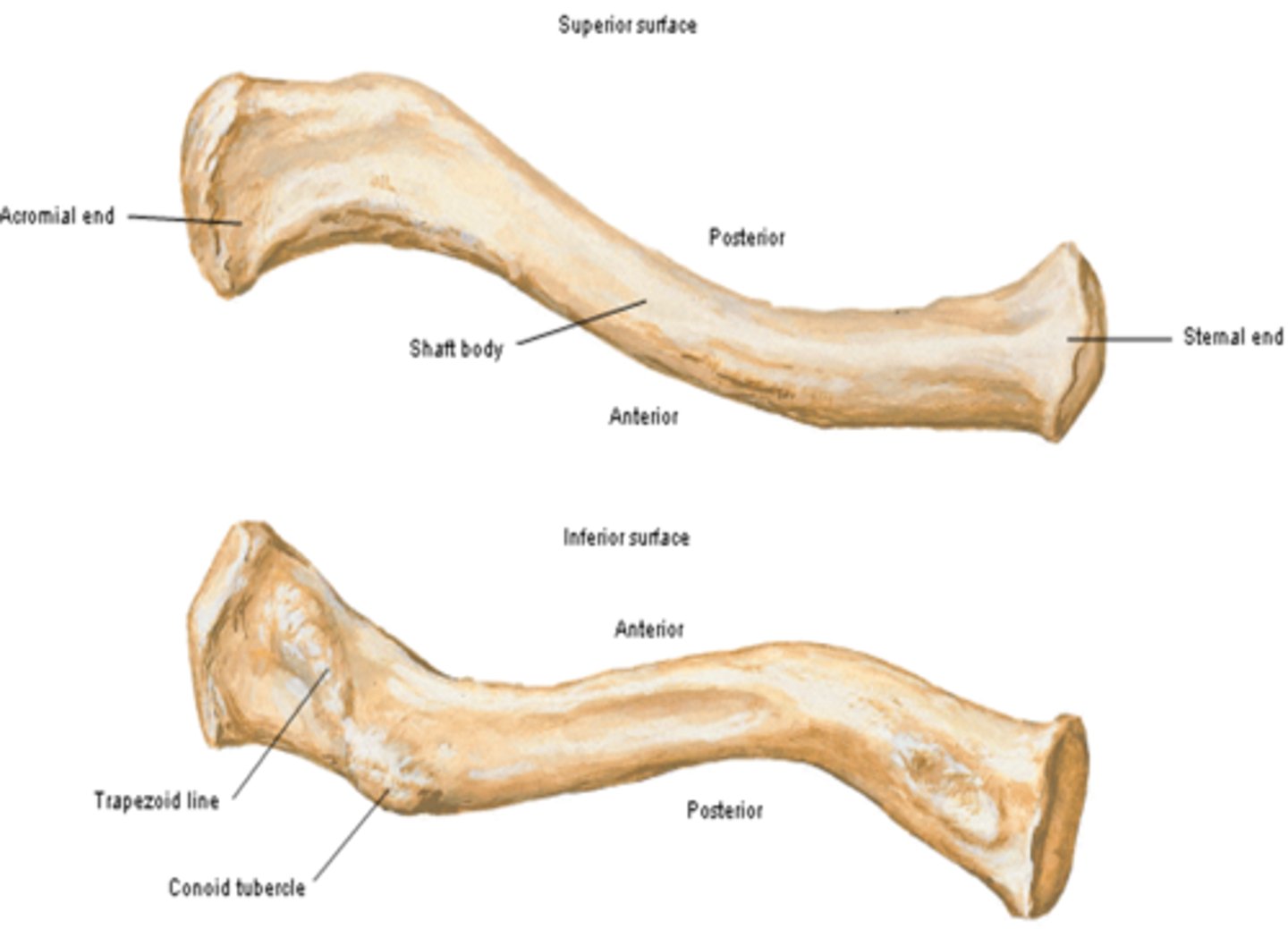
inferior surface of clavicle
rough surface with ligaments binding to it
-Conoid tubercule and trapezoid line
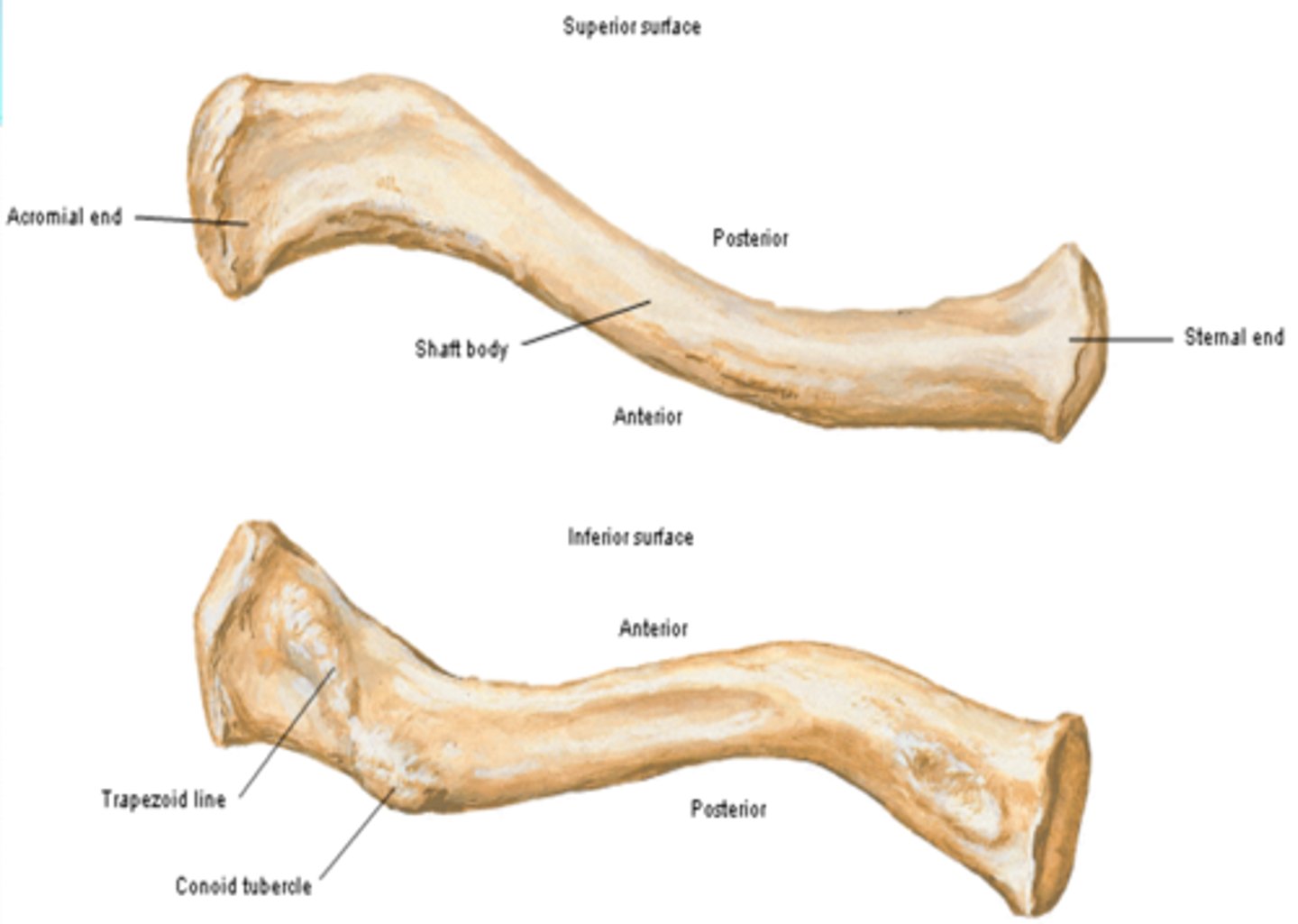
Inferior surface of clavicle: conoid tubercule
near acromial end of clavicle, support for the medial part of the coracoclavicular ligament

inferior surface of clavicle: trapezoid
nearer to the acromial end than the conoid tubercle, support for the lateral part of the coracoclavicular ligament.
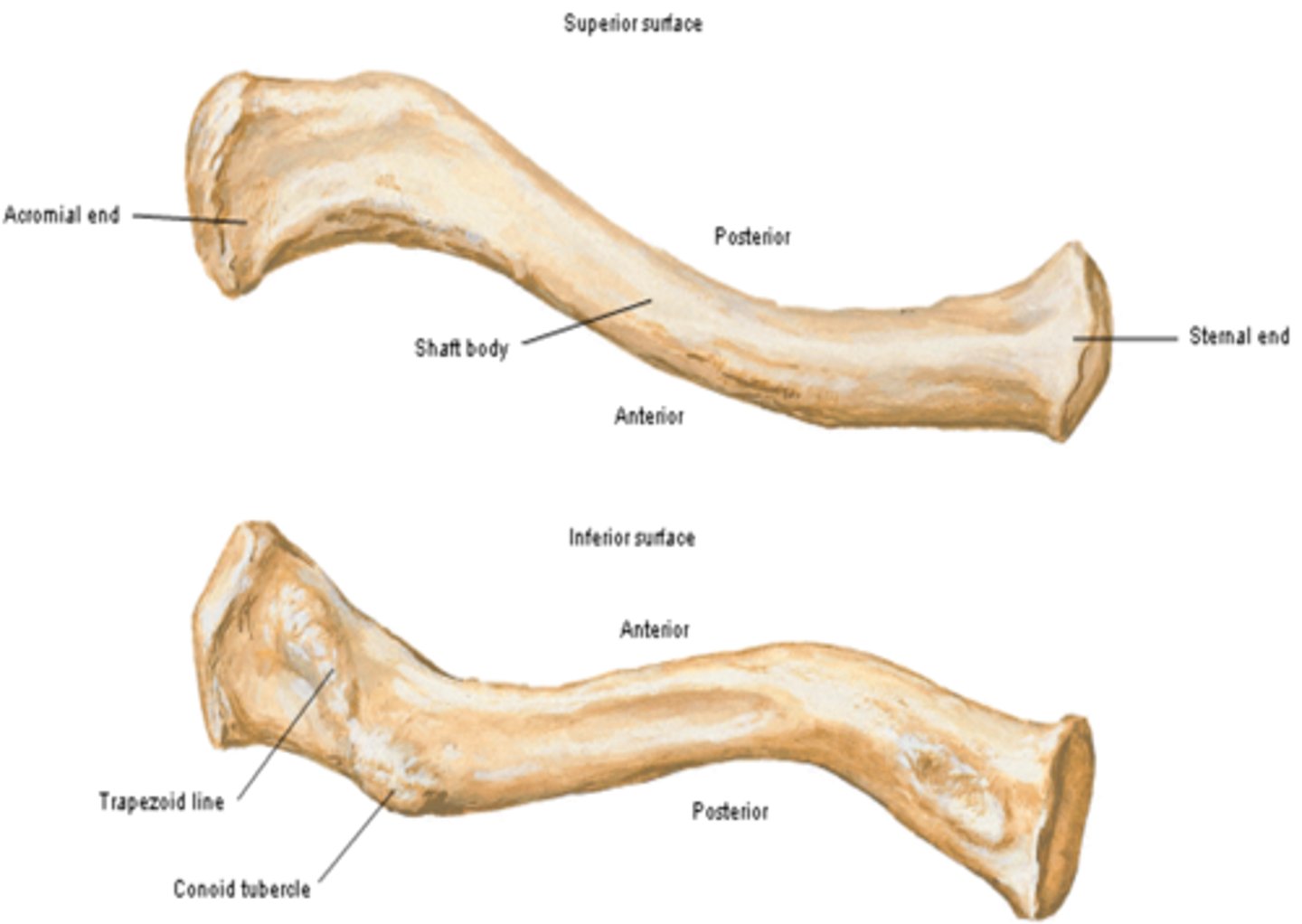
A patient comes in with a fracture of their clavicle in the junction between the medial 2/3rd and lateral 1/3rd. The medial 2/3rd is going to be displaced superiorly by the action of the SCM muscle. What point is this?
(clinical relevance)
The inflection point. It is the weakest point of the clavicle, more prone to fractures
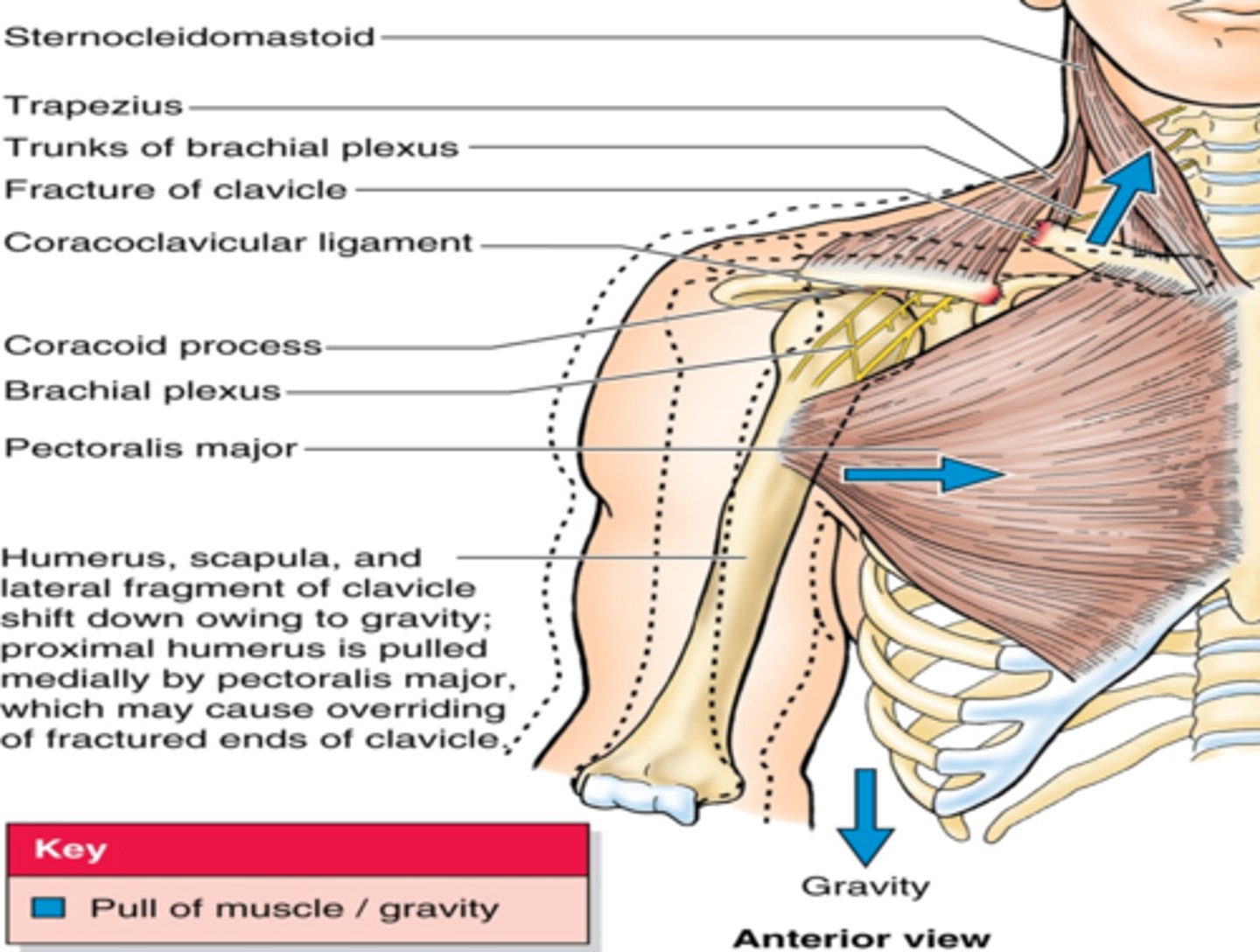
Scapula
•Triangular flat bone
•Location: posterior part of the thorax, overlying 2nd – 7th ribs
•Articulates: humerus (joint) and thoracic wall (physiological scapula-thoracic joint)
•Surfaces, a total of 3 of them
•Posterior
•Costal and
•Lateral
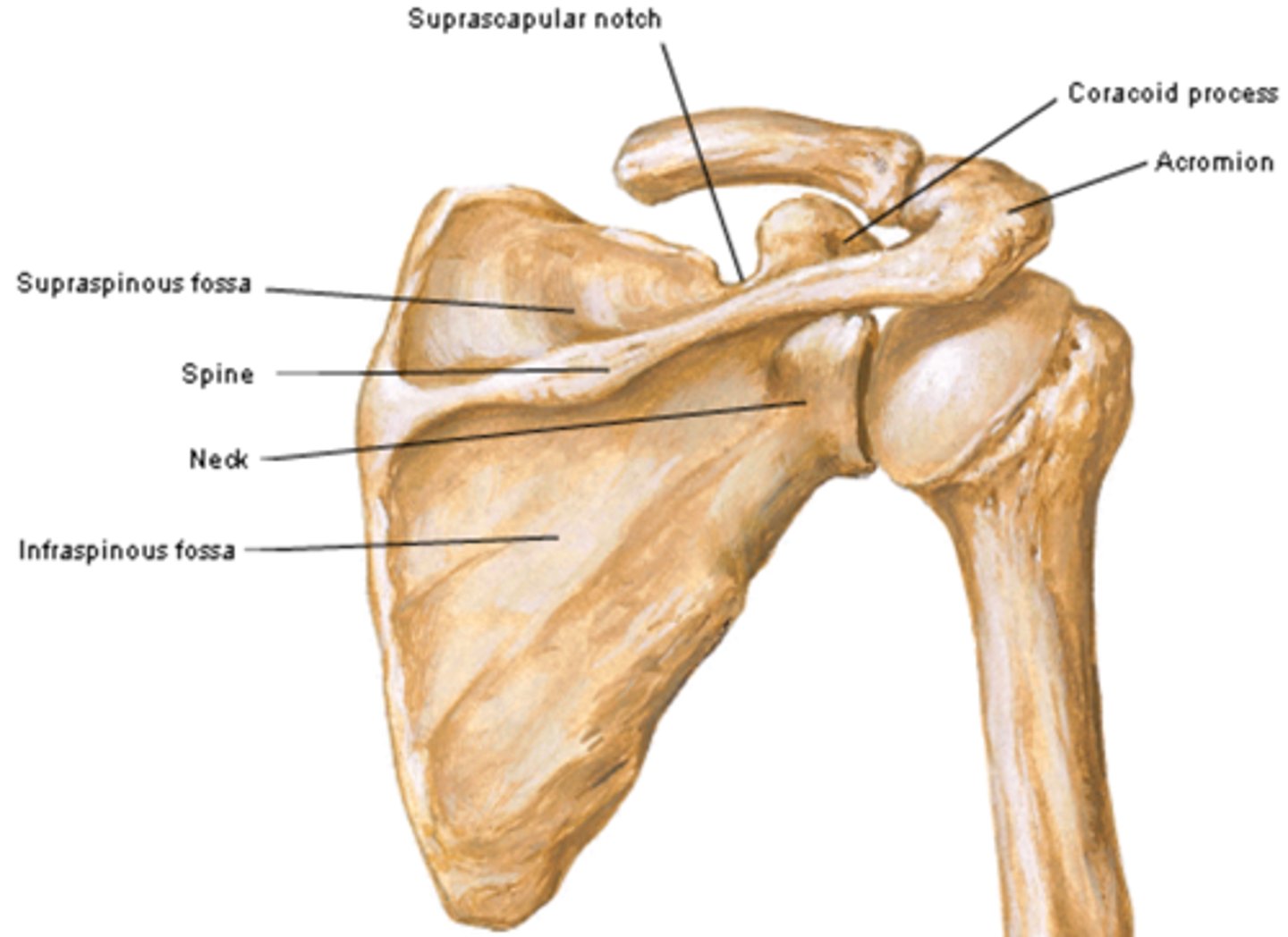
Scapula is a
Triangular flat bone
The location of the Scapula is
posterior part of the thorax, overlying 2nd - 7th ribs
The scapula articulates with
humerus (joint) and thoracic wall (physiological scapula-thoracic joint)
How many surfaces does the scapula have? what are they?
Three surfaces:
1.Posterior
2.Coastal
3.Lateral
Scapula surface: Posterior Surface
Is convex and contains:
-Spine of scapula: ridge of bone that divides posterior surface in two fossae
-Acromion: lateral continuation of the spine
-Supraspinous fossa: above the spine of the scapula
-Infraspinous fossa: inferior to the spine of the scapula

Scapula posterior surface: Spine of Scapula
ridge of bone that divides posterior surface in two fossae
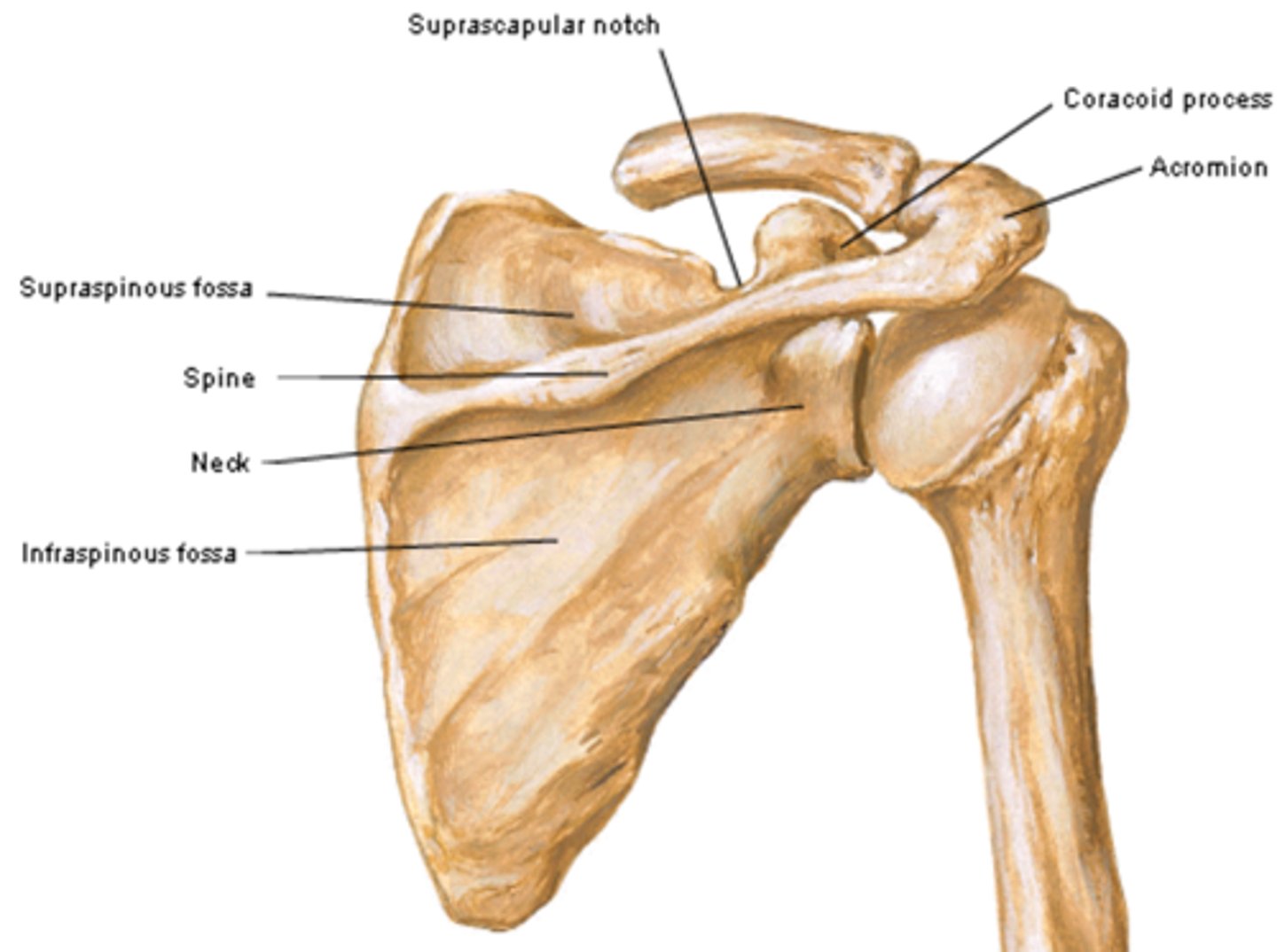
Scapula posterior surface: Acromion
lateral continuation of the spine
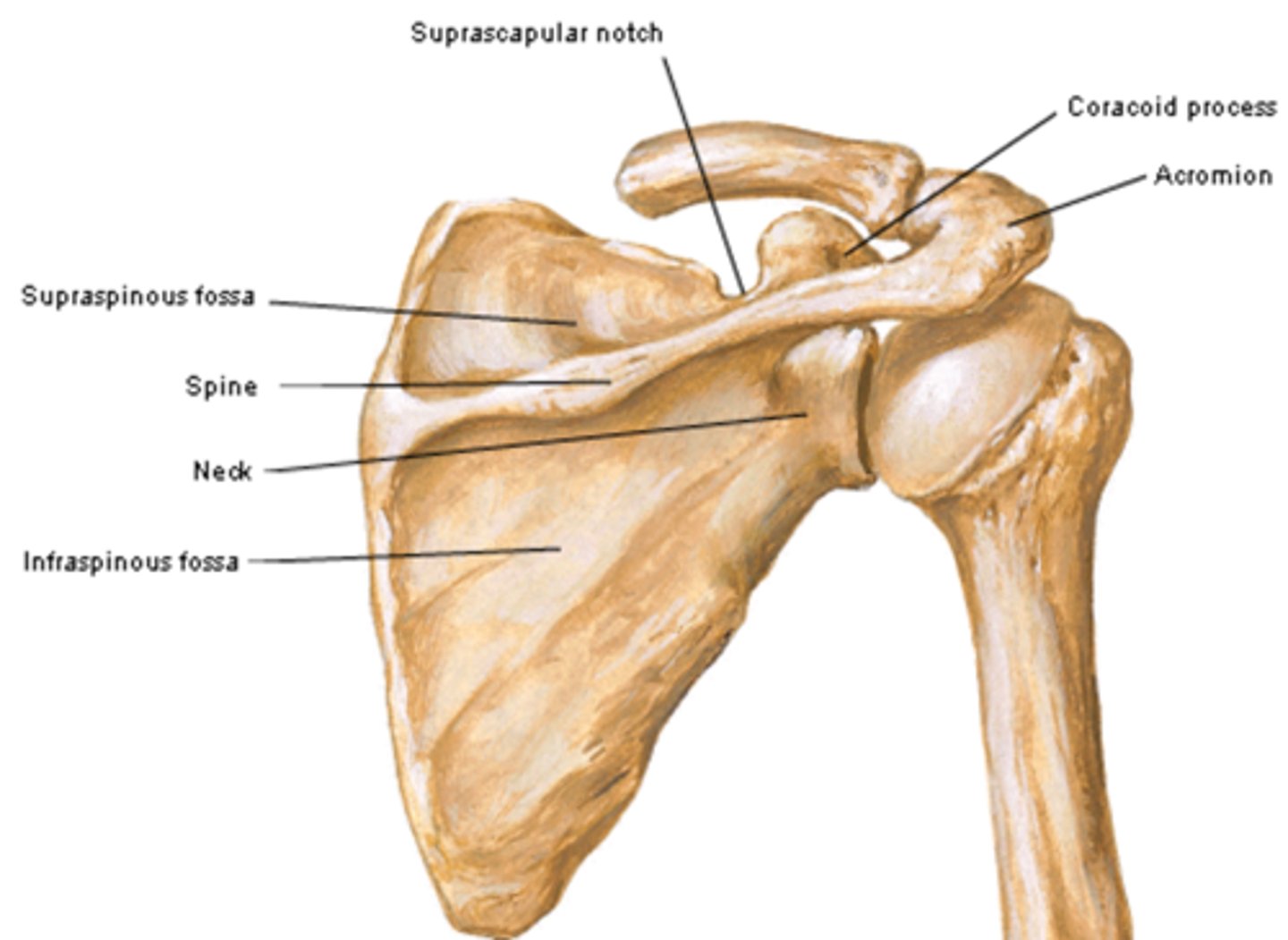
Scapula posterior surface: Supraspinous fossa
above the spine of the scapula

Scapula posterior surface: infraspinous fossa
inferior to the spine of the scapula
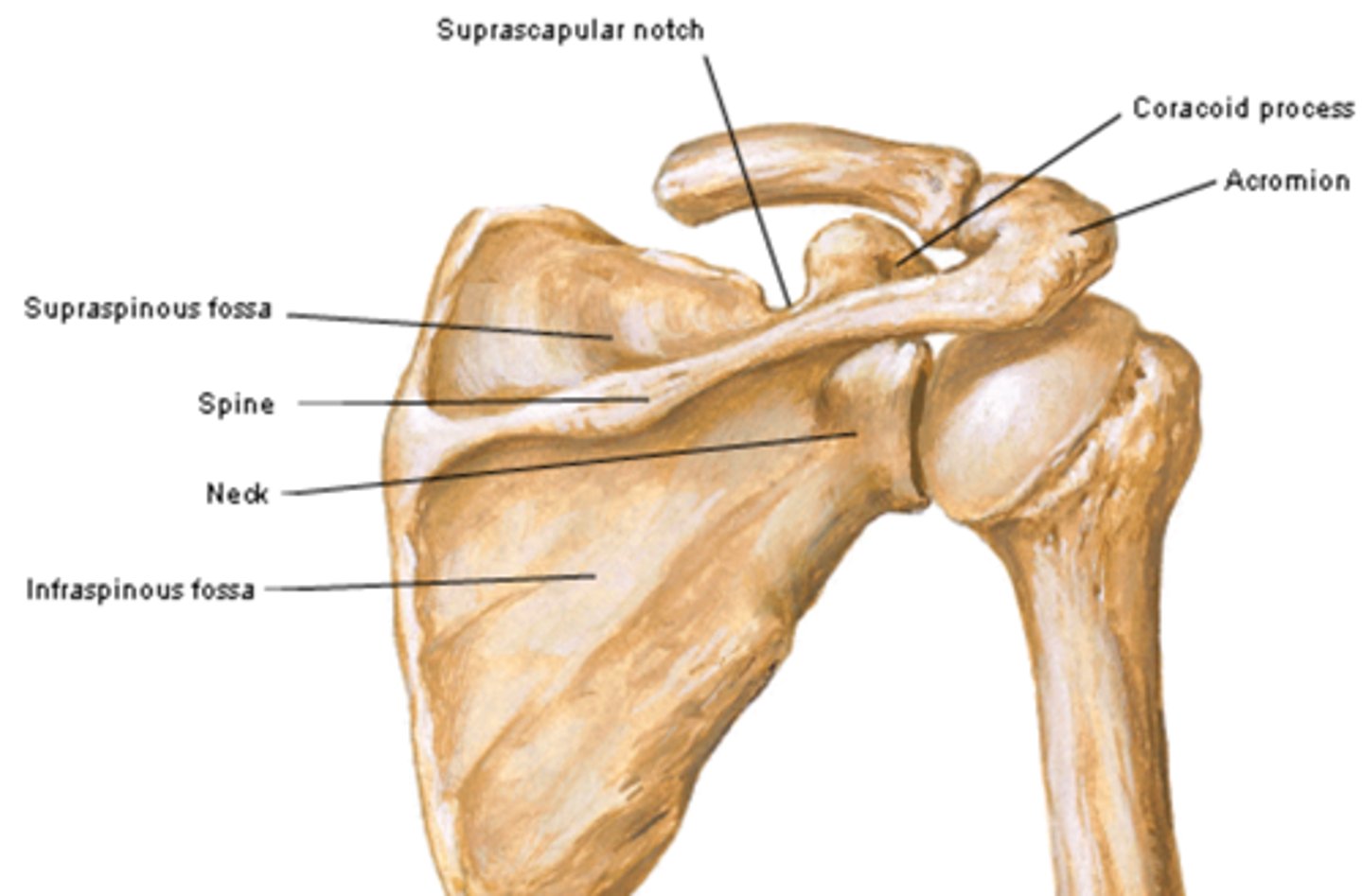
Scapula surfaces: Coastal Surface
Is concave and contains
Subscapular fossa: occupies most of the costal surface
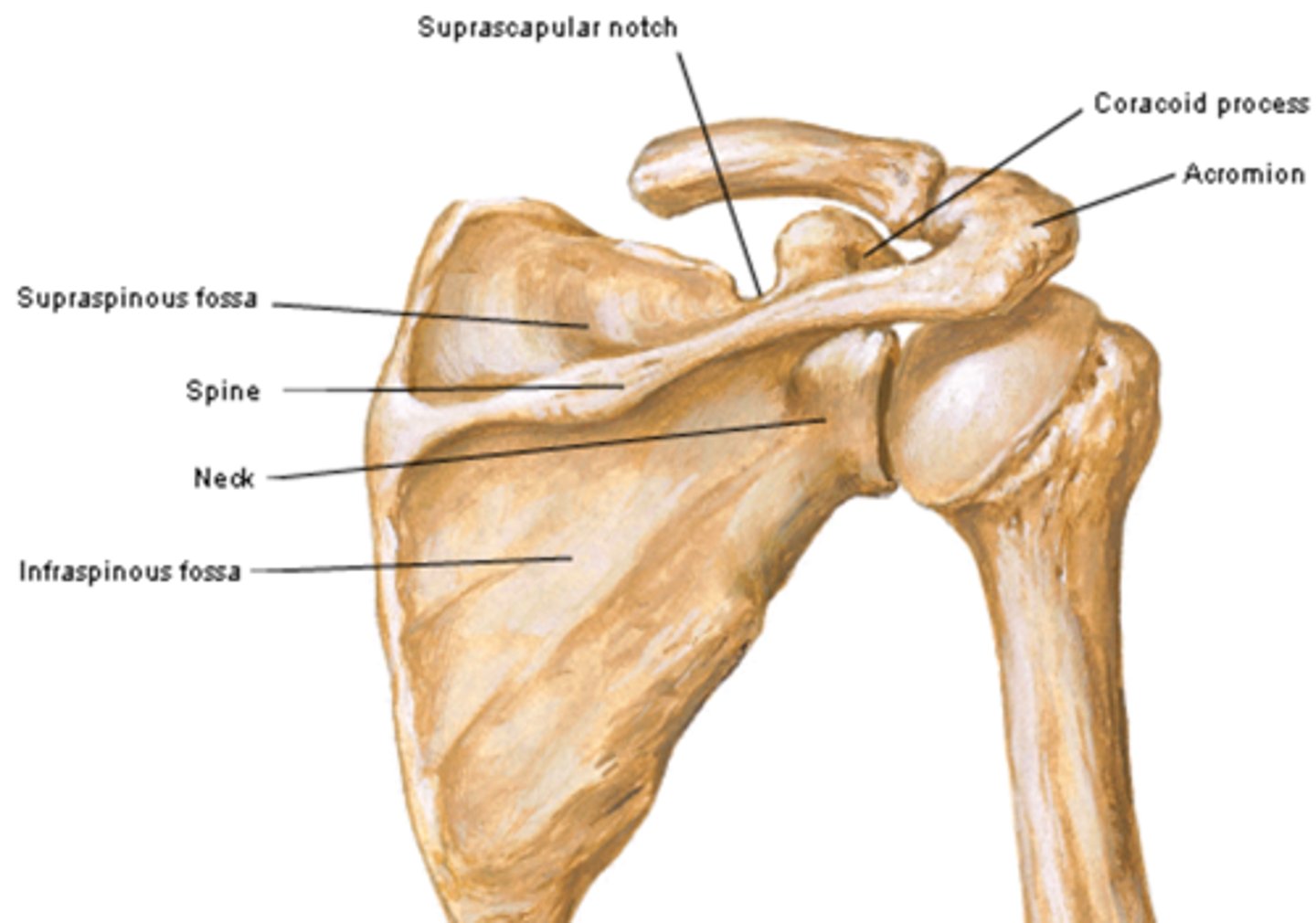
Scapula coastal surface: Subscapular fossa
occupies most of the costal surface
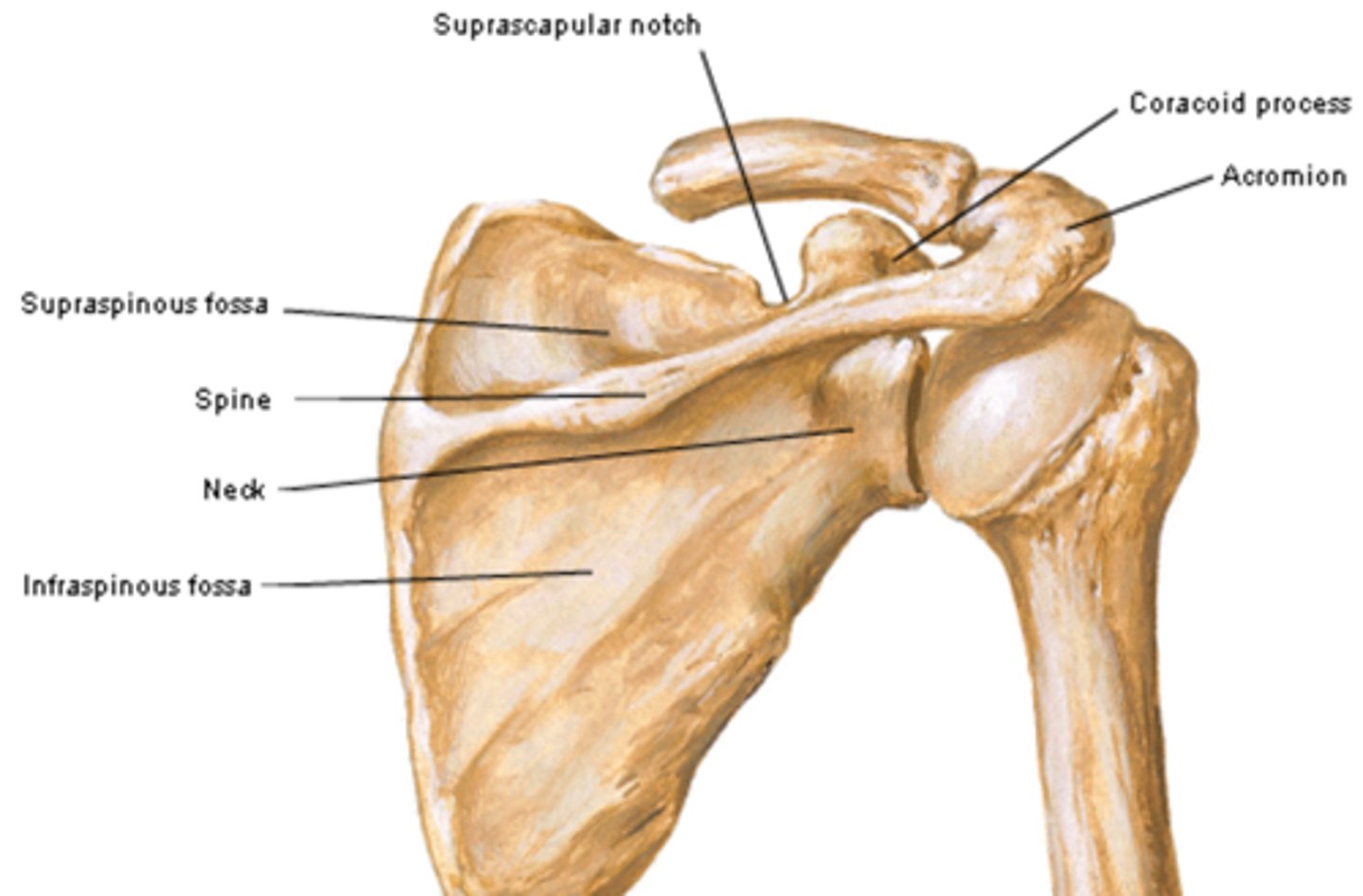
scapula surfaces: Lateral Surface
contains the
-Glenoid cavity: located superolaterally receives and articulates with the head of the humerus (glenohumeral joint)
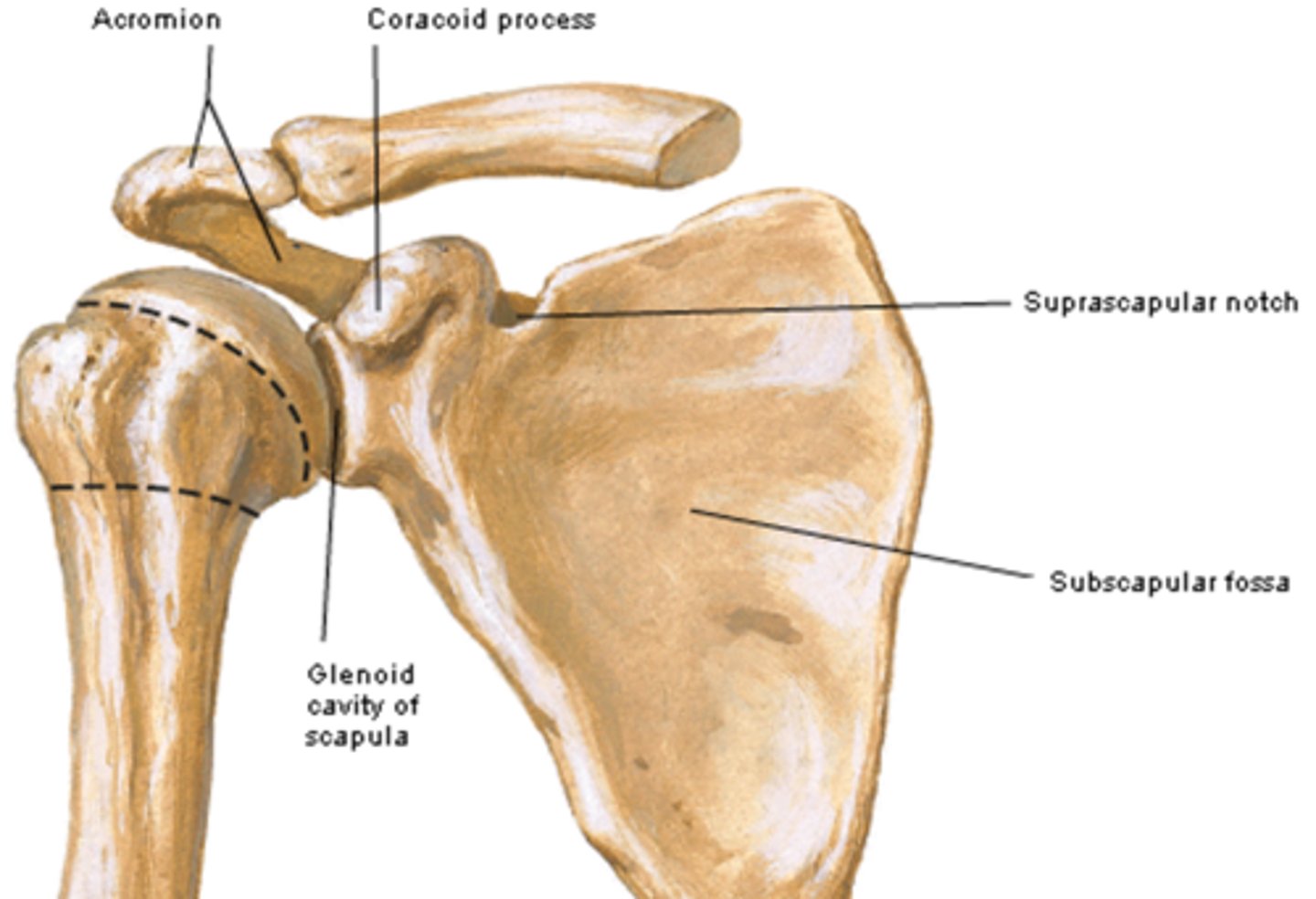
Scapula lateral surfaces: Glenoid Cavity
located superolaterally receives and articulates with the head of the humerus (glenohumeral joint)
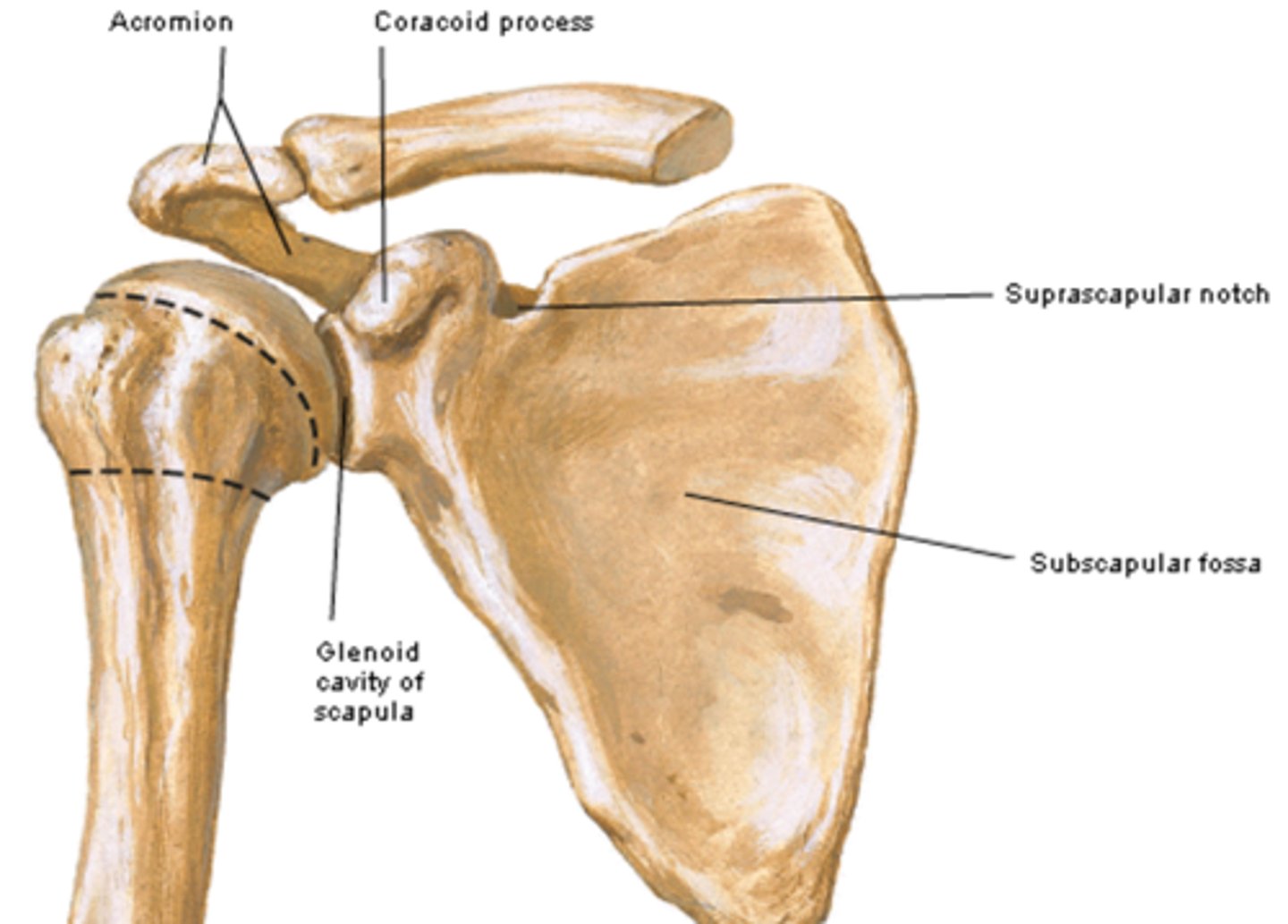
Caracoid process
superior to the glenoid cavity, projects anterolaterally

Head of scapula
contains the glenoid cavity
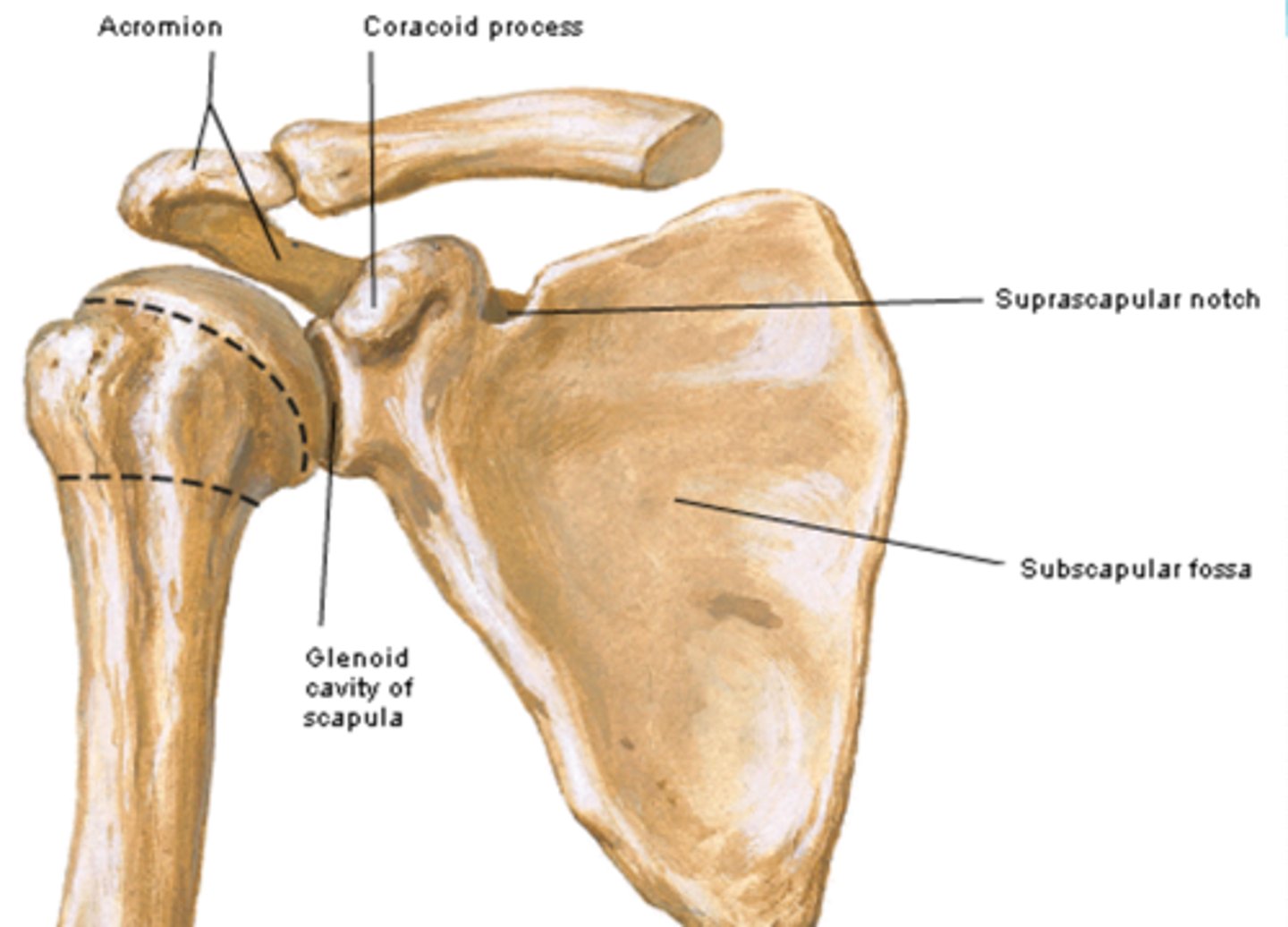
neck of scapula
between the head and body of scapula

suprascapular notch
junction of the superior border with the base of the coracoid process. This notch is converted into a foramen by the superior transverse ligament, and serves for the passage of the suprascapular nerve

scapula borders
superior, medial (vertebral), lateral (axillary)
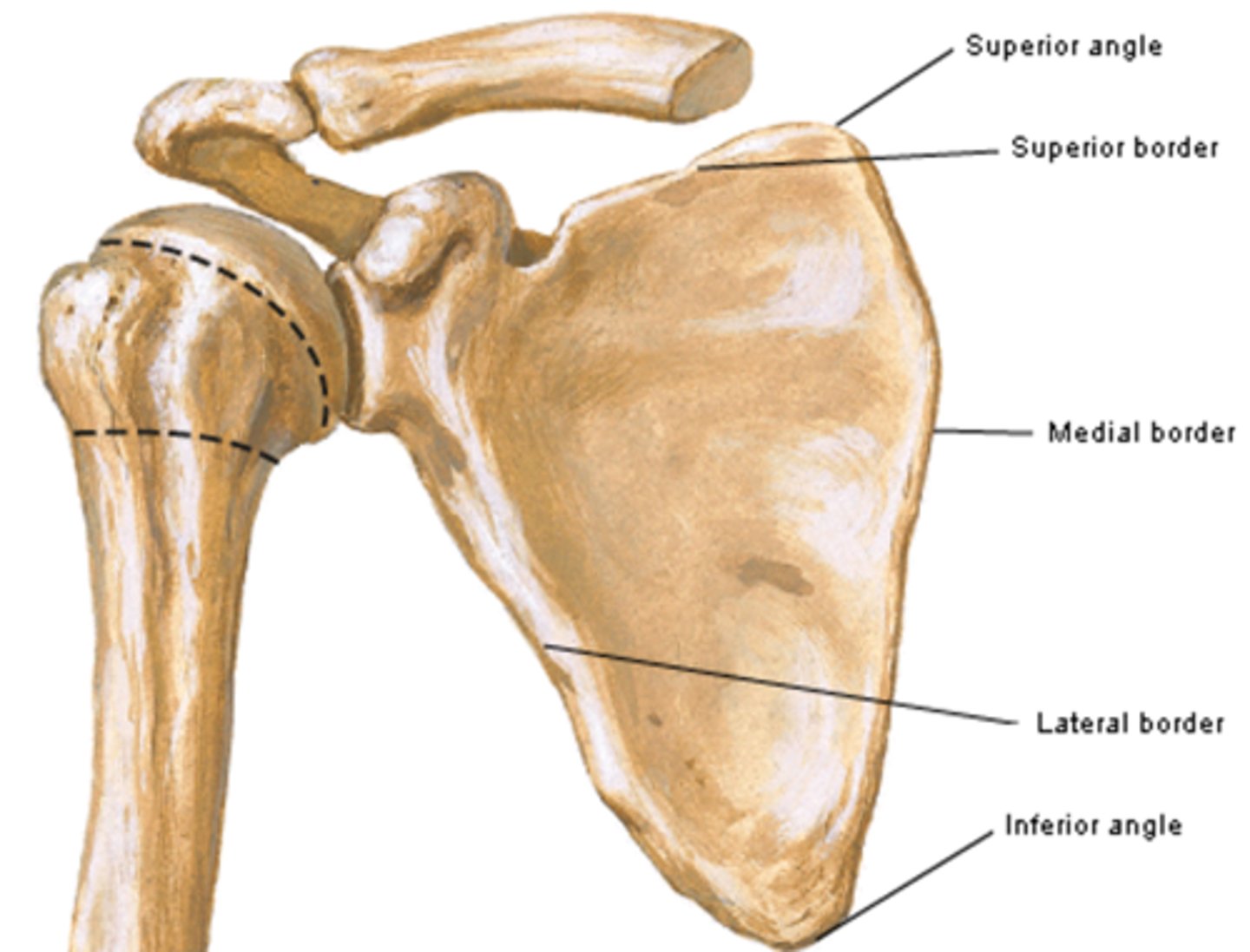
superior scapula border
near the suprascapular notch
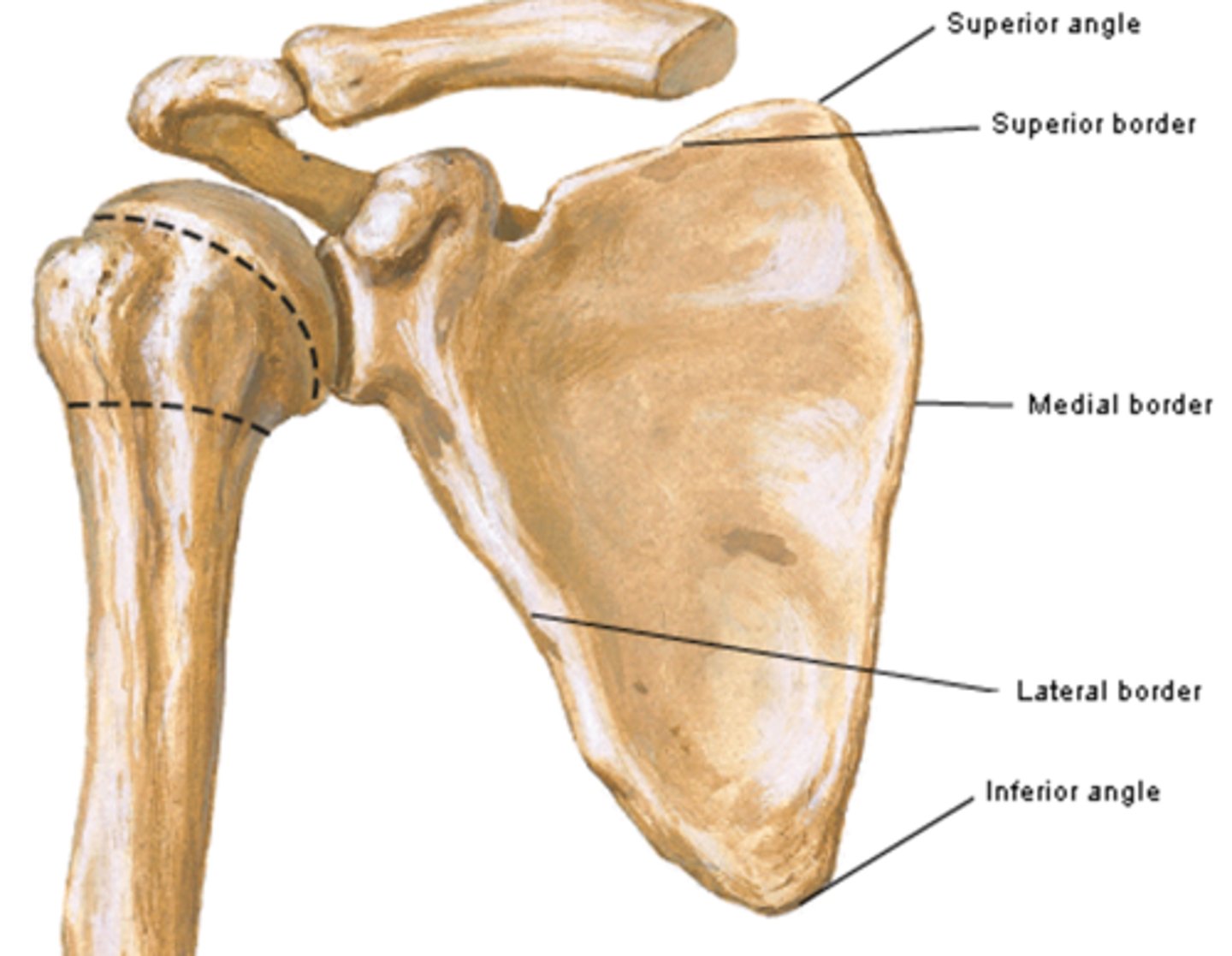
lateral border of scapula
near the humerus
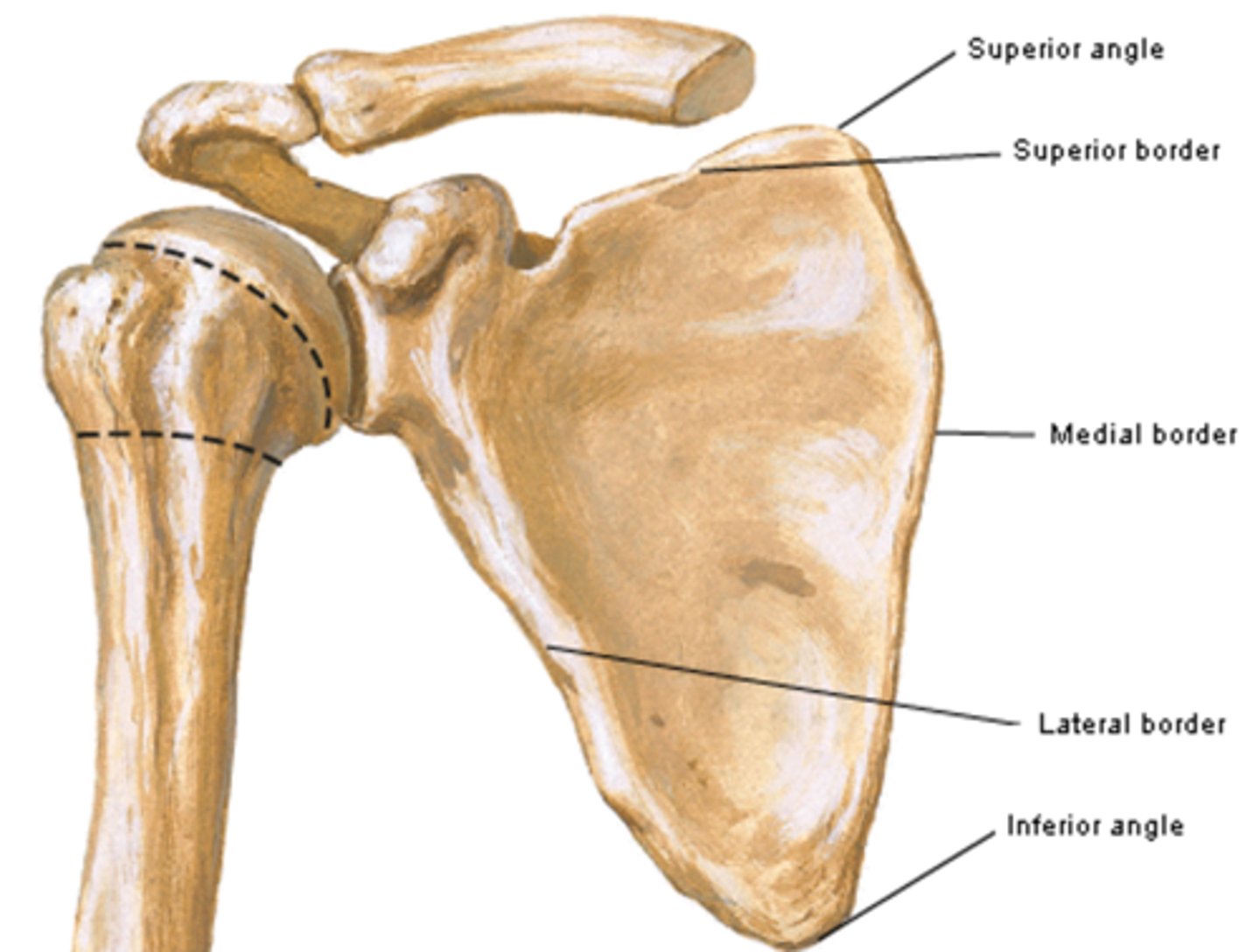
medial border of scapula
runs parallel to spinous processes of the vertebrae
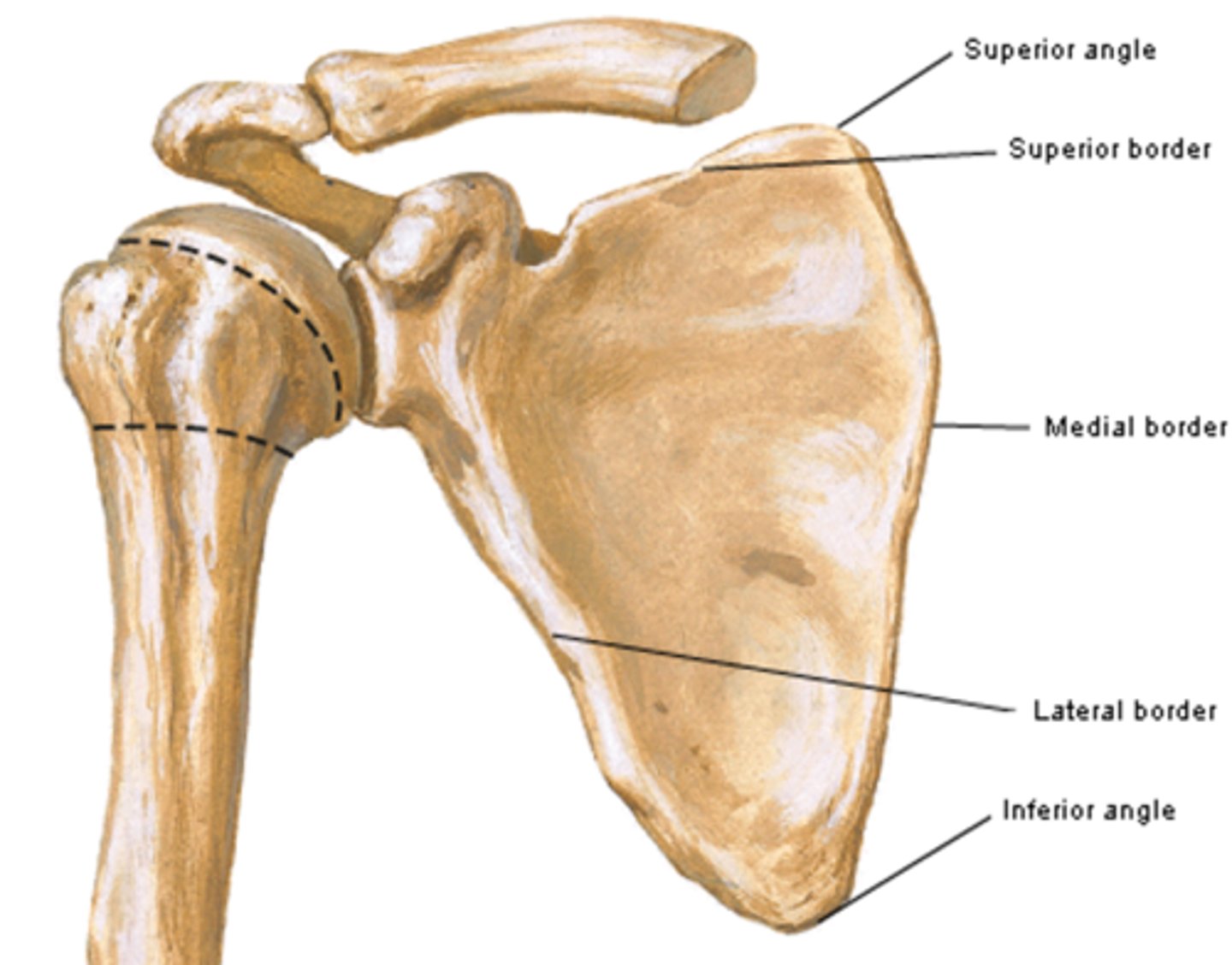
scapula angles
superior, inferior, lateral
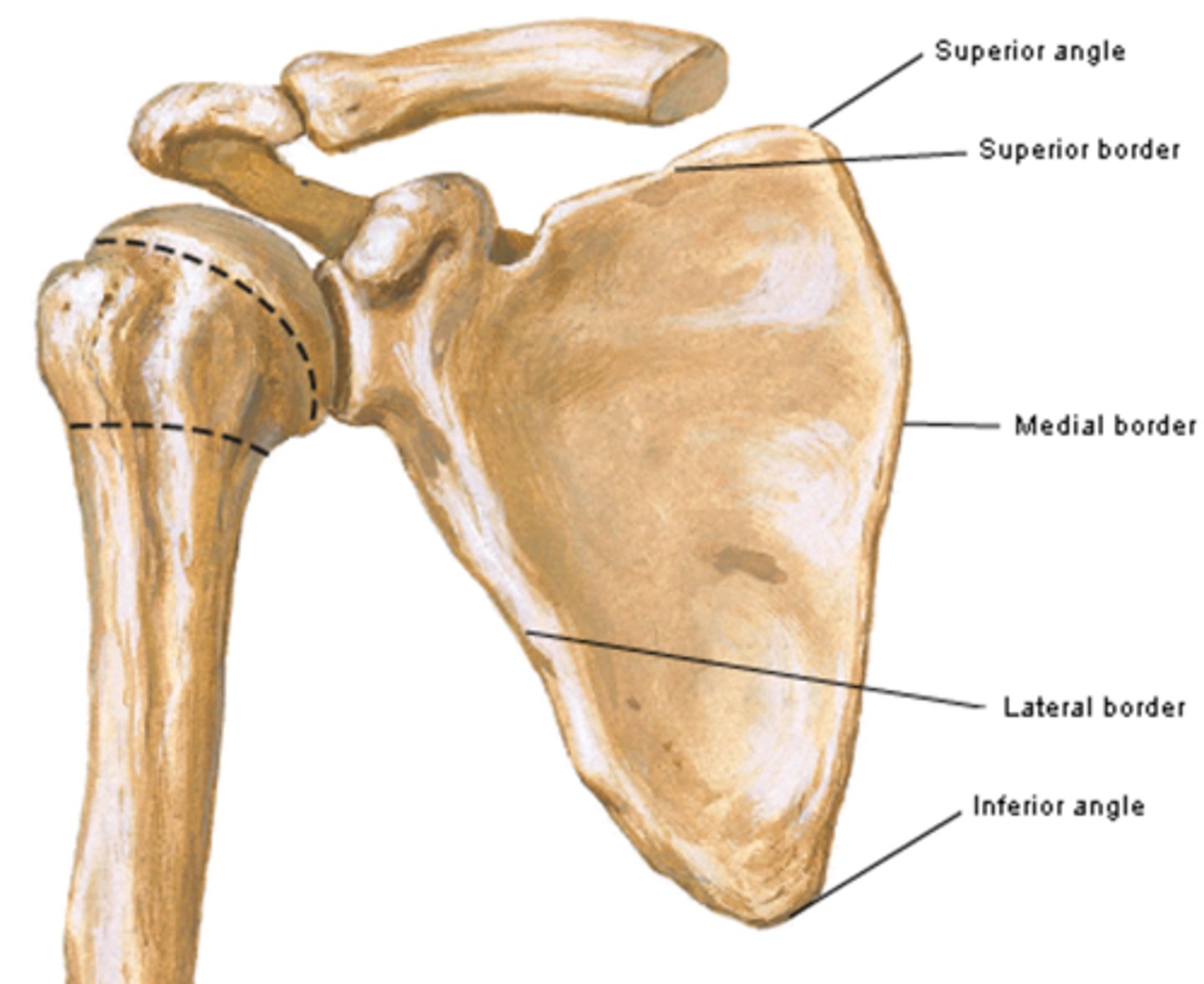
superior angle of scapula
union of superior and medial borders
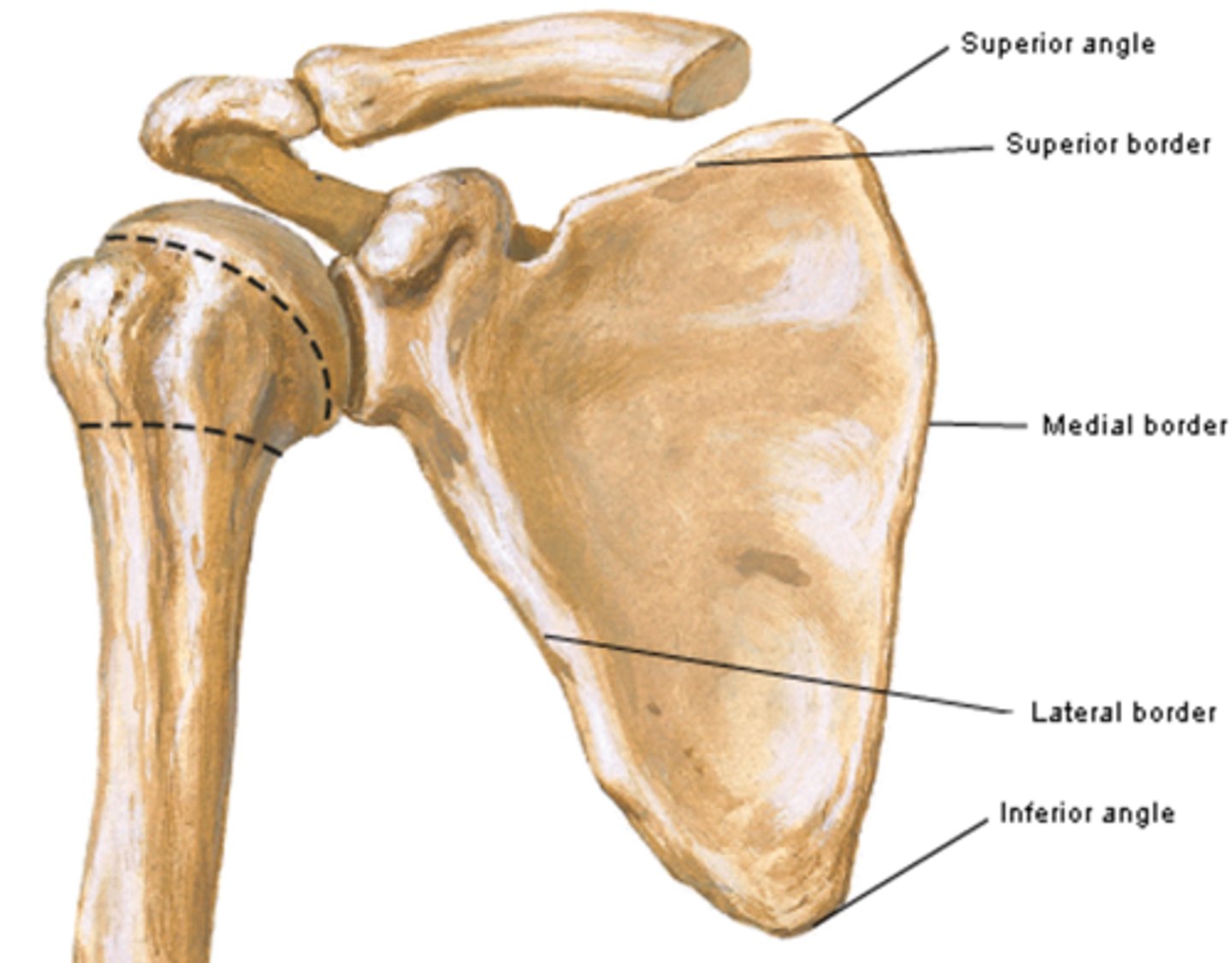
inferior angle of scapula
union of medial and lateral borders
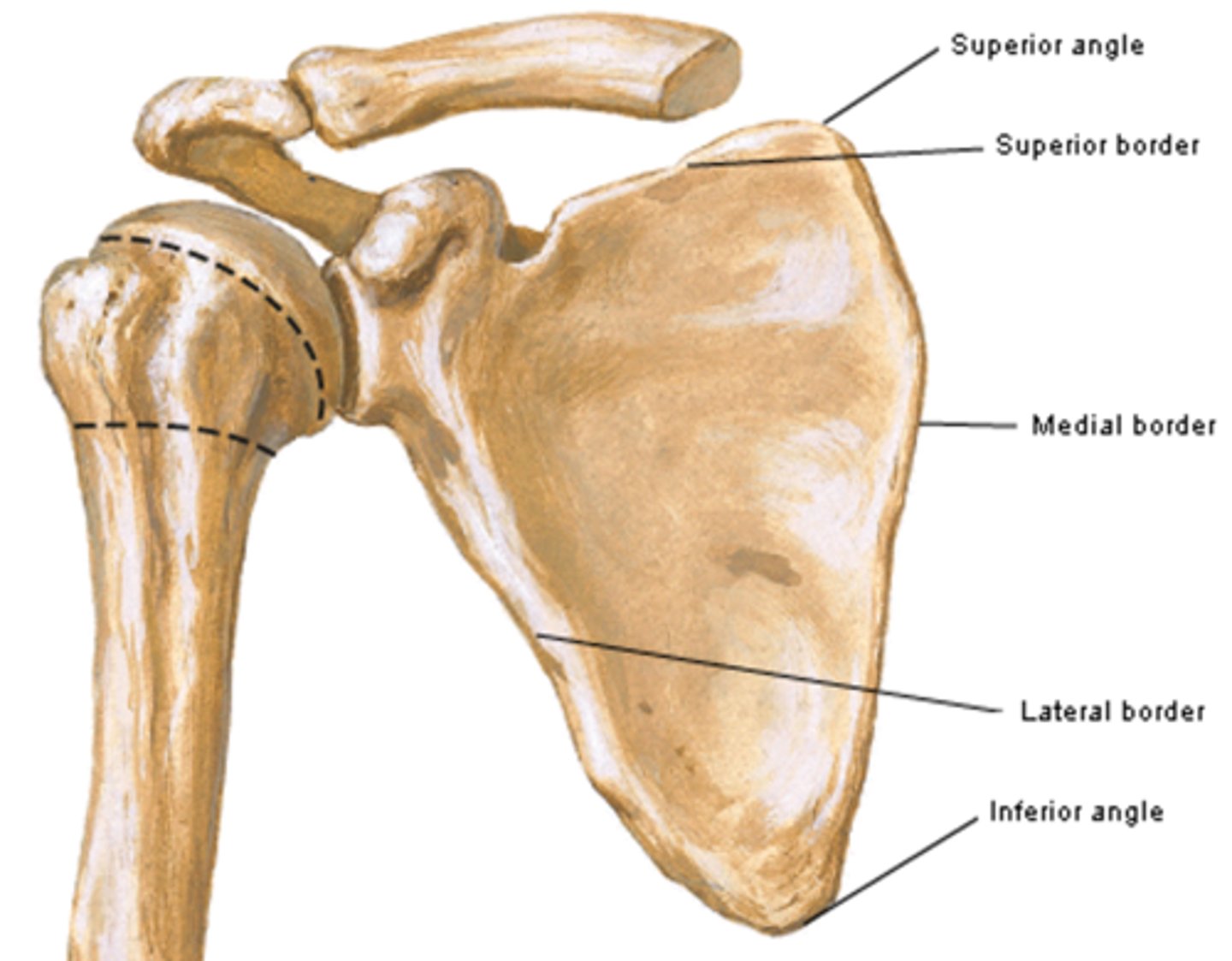
lateral angle of scapula
contains the head of the scapula
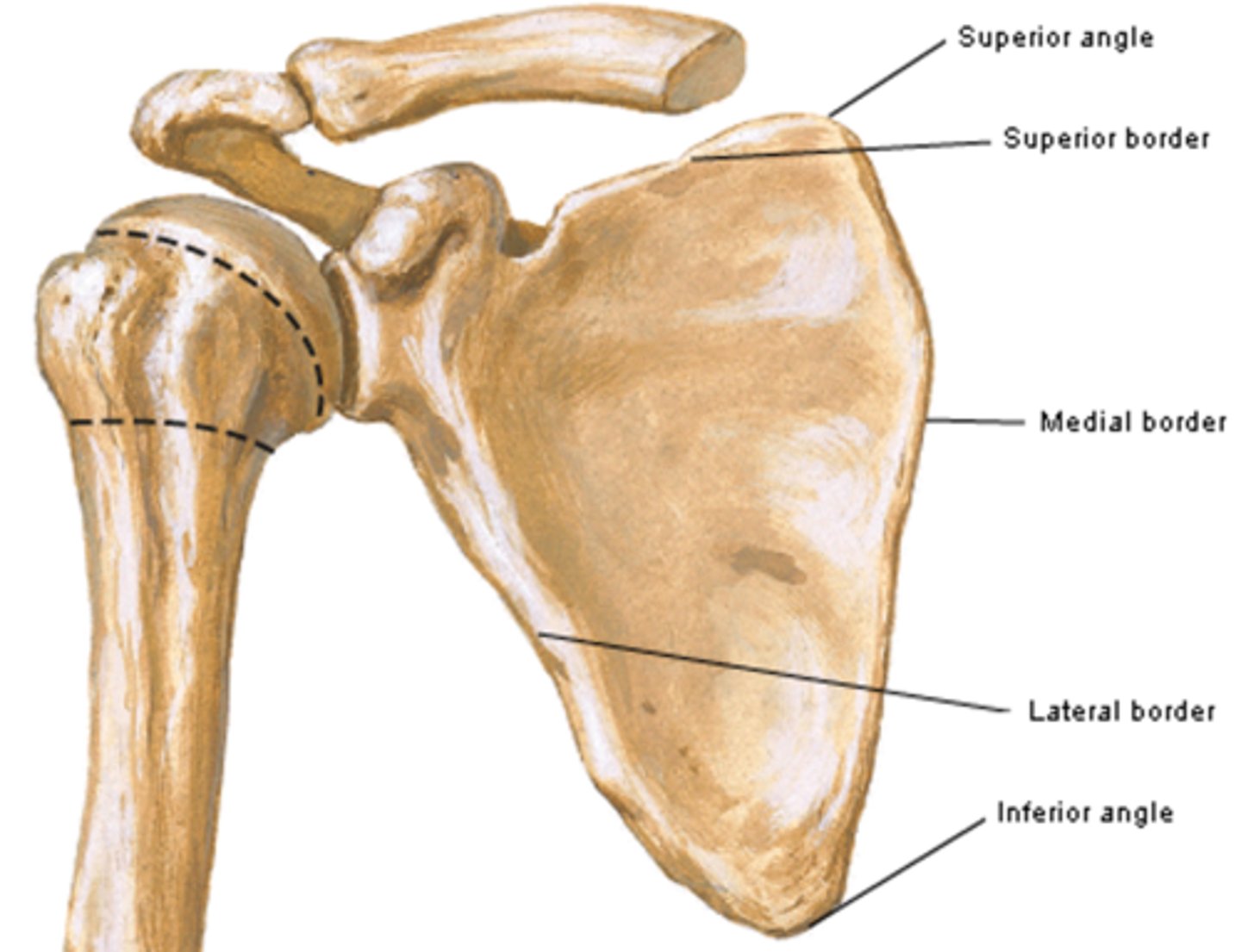
Humerus (bone of the arm)
The largest bone in the upper extremity
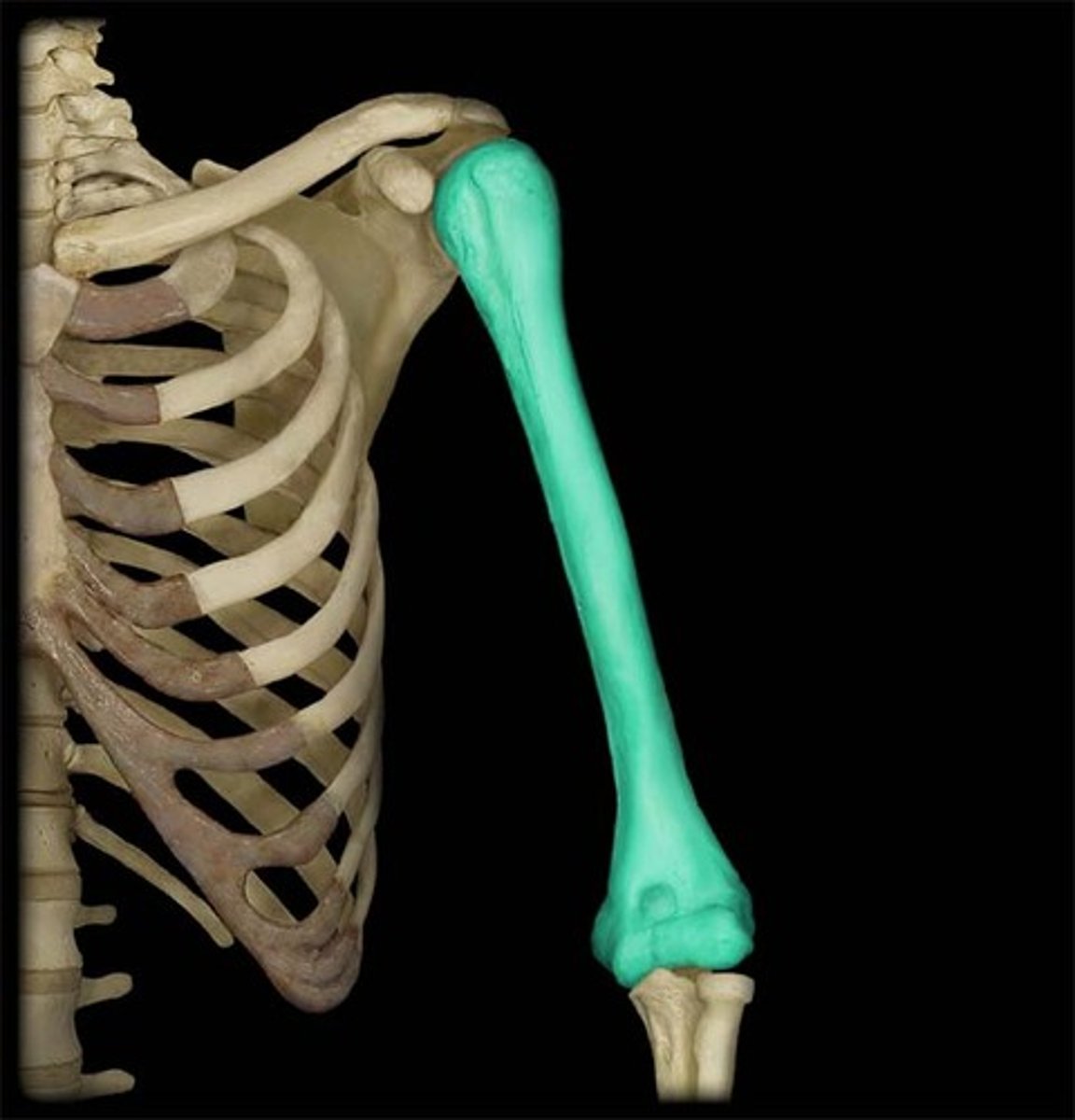
The humerus articulates
the scapula (glenohumeral joint) and radius and ulna (elbow joint)
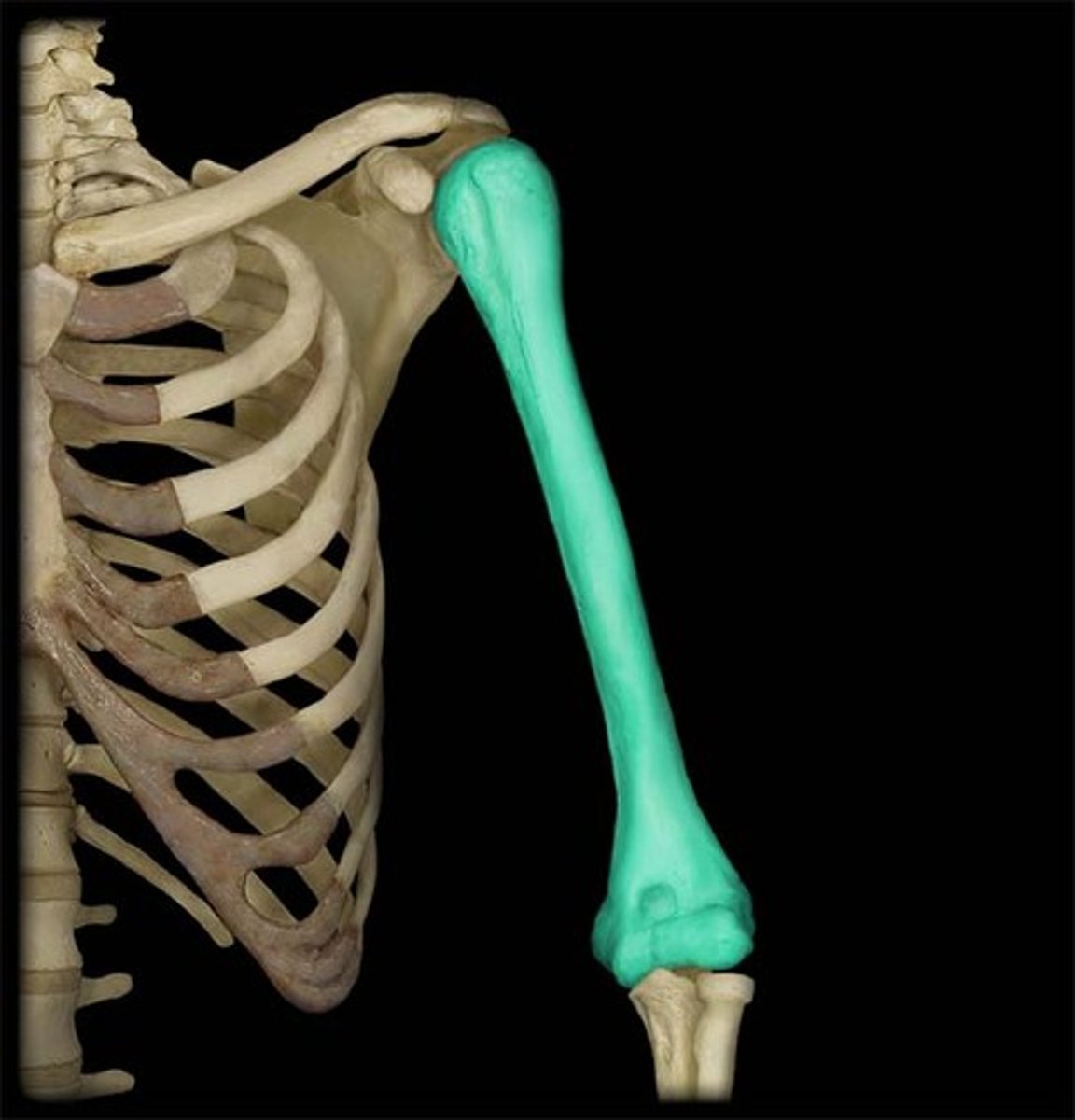
Humerus features
-Head
-Anatomical neck
-Surgical neck
-Greater tubercle
-Lesser tubercle
-Intertubercular groove
-Shaft
-Deltoid tuberosity
-Radial groove
-Medial and lateral supra-epicondylar ridges
-Condyle
-Capitulum
-Trochlea
-Coronoid fossa
-Olecranon fossa
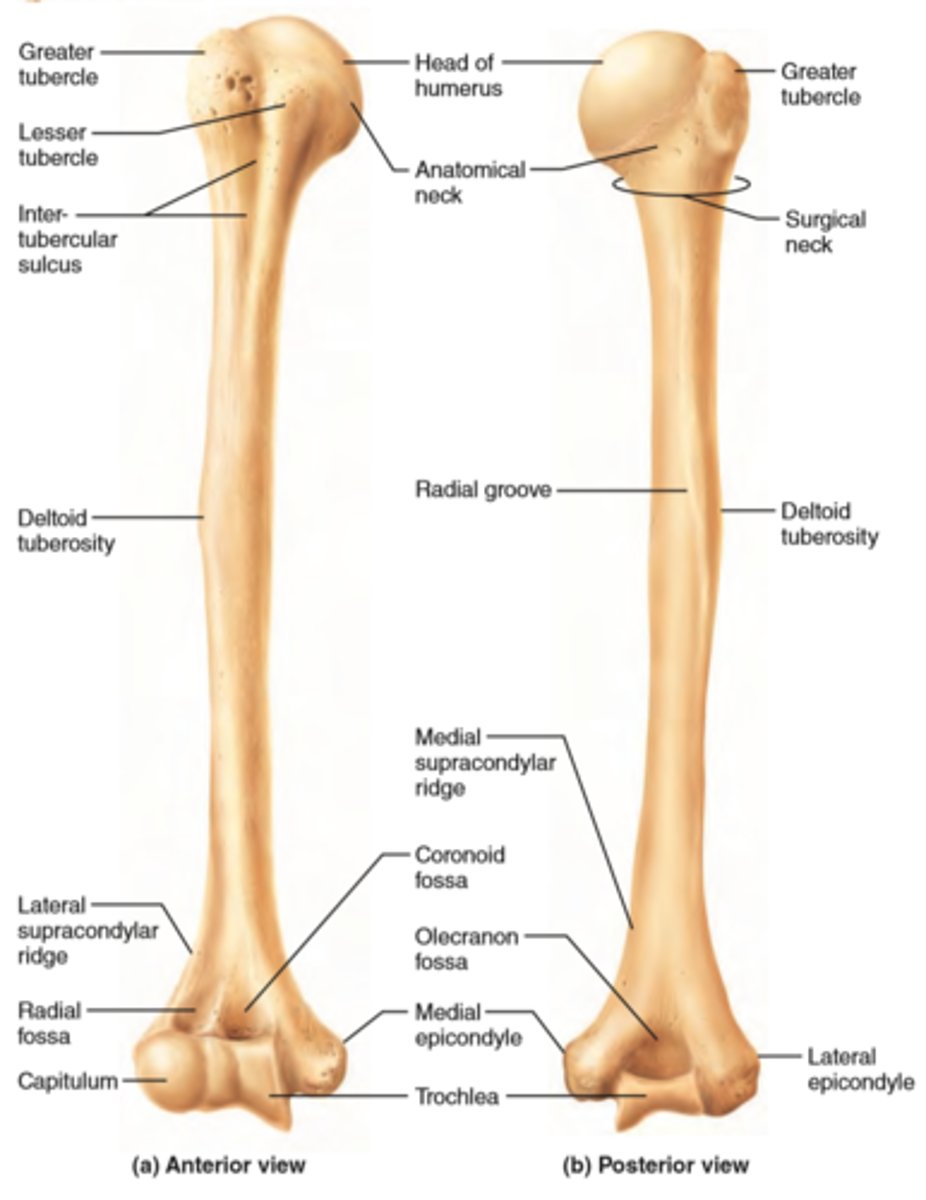
humerus head
articulates with glenoid cavity of scapula
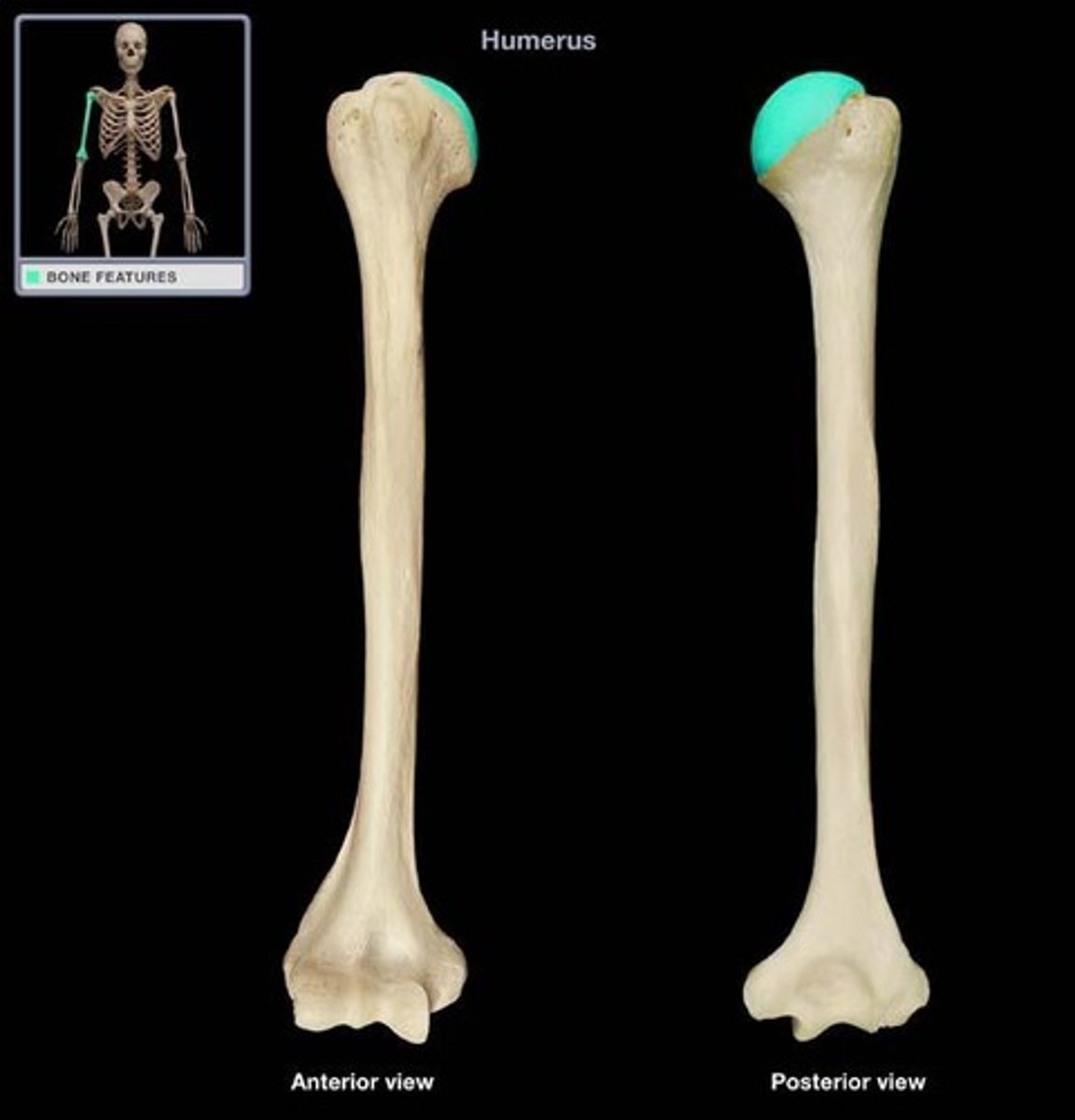
humerus anatomical neck
groove separating the head from the greater and lesser tubercles. Indicates the place of attachment of the glenohumeral joint capsule

humerus surgical neck
narrow part distal to head and tubercles. Common site of fracture
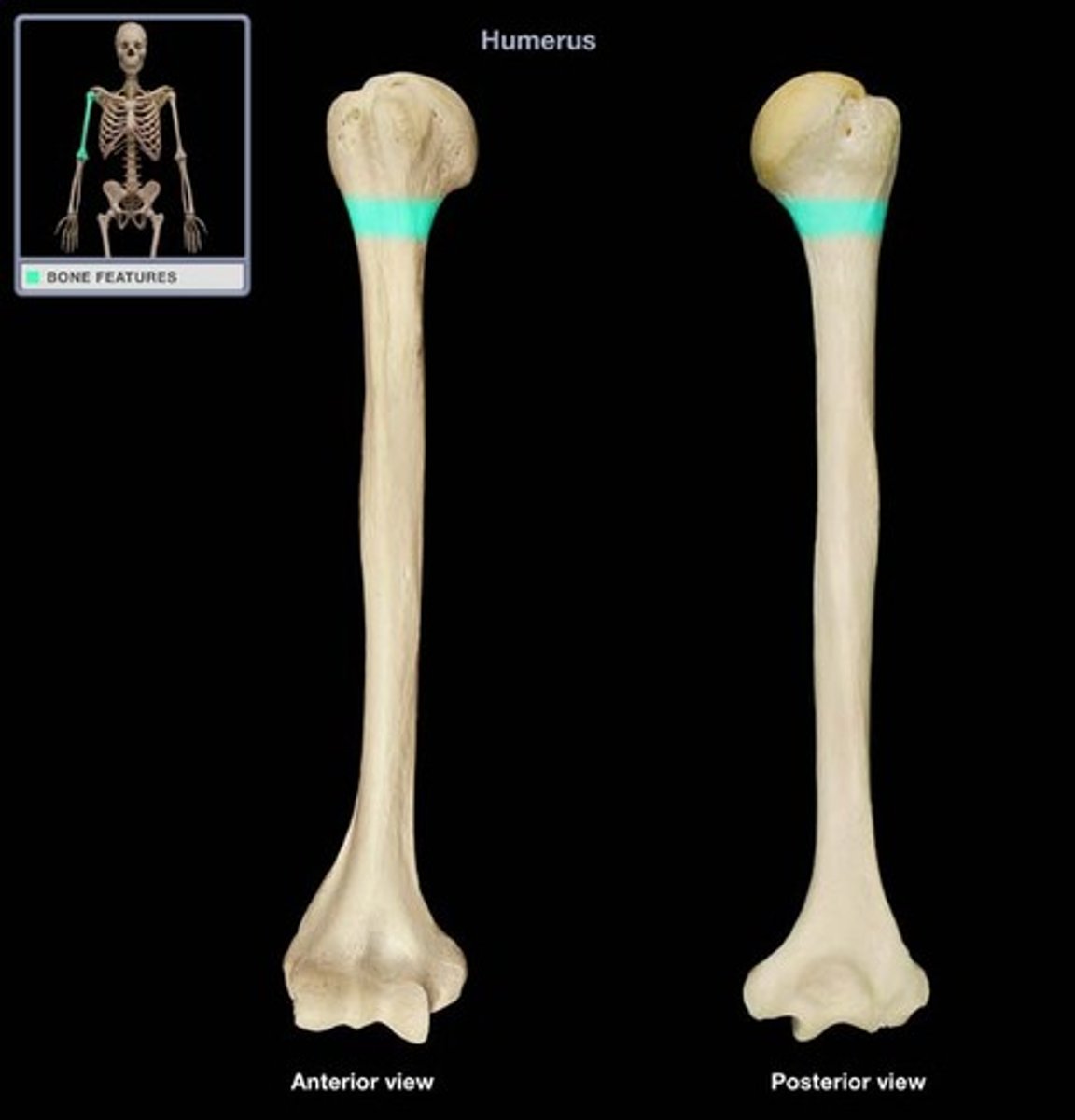
Humerus greater tubercule
lateral position from head
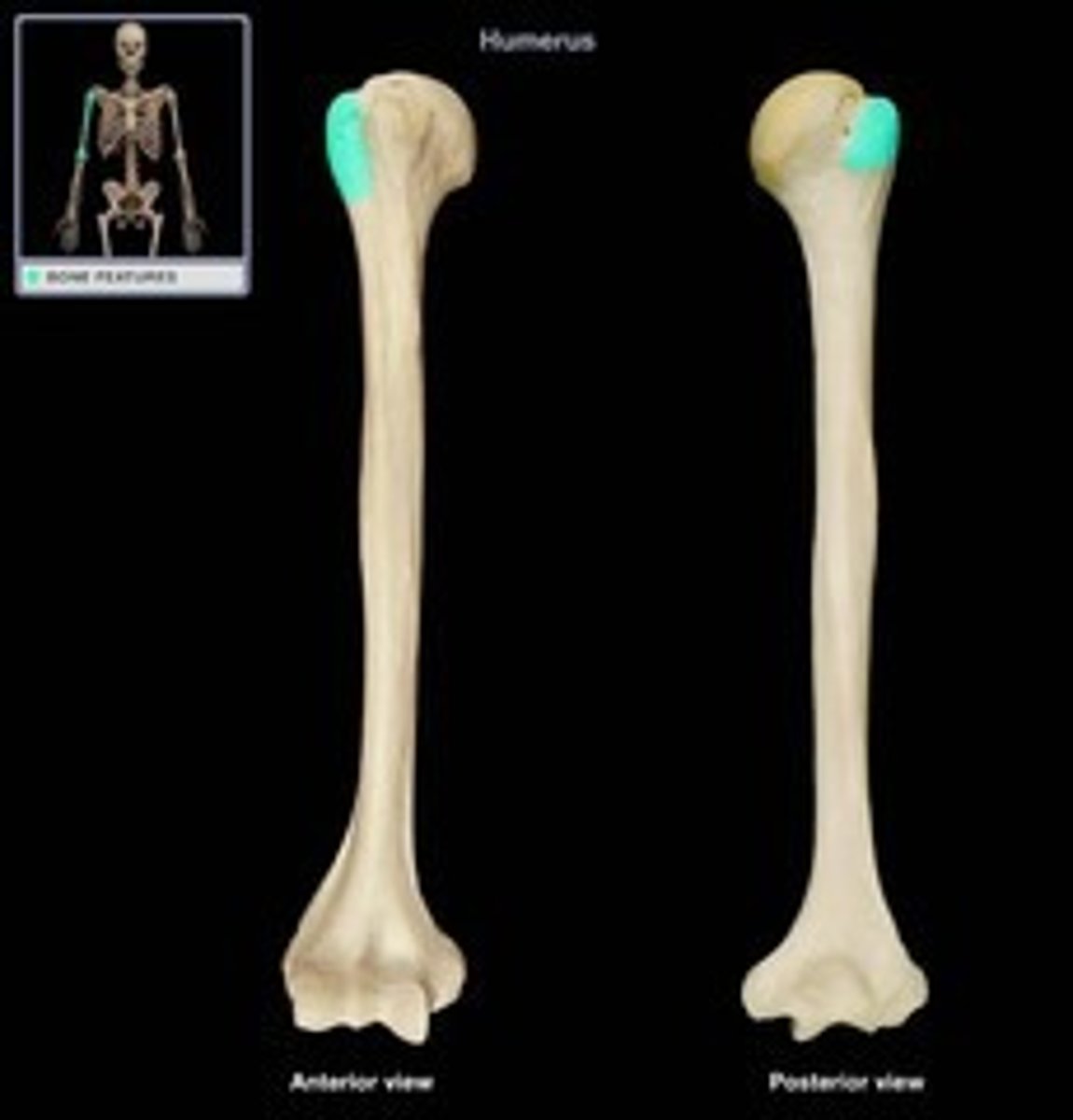
Humerus lesser tubercule
anterior position from the head

humerus intertubercular groove
located between tubercles and provides passage for the tendon of the long head of the biceps muscle
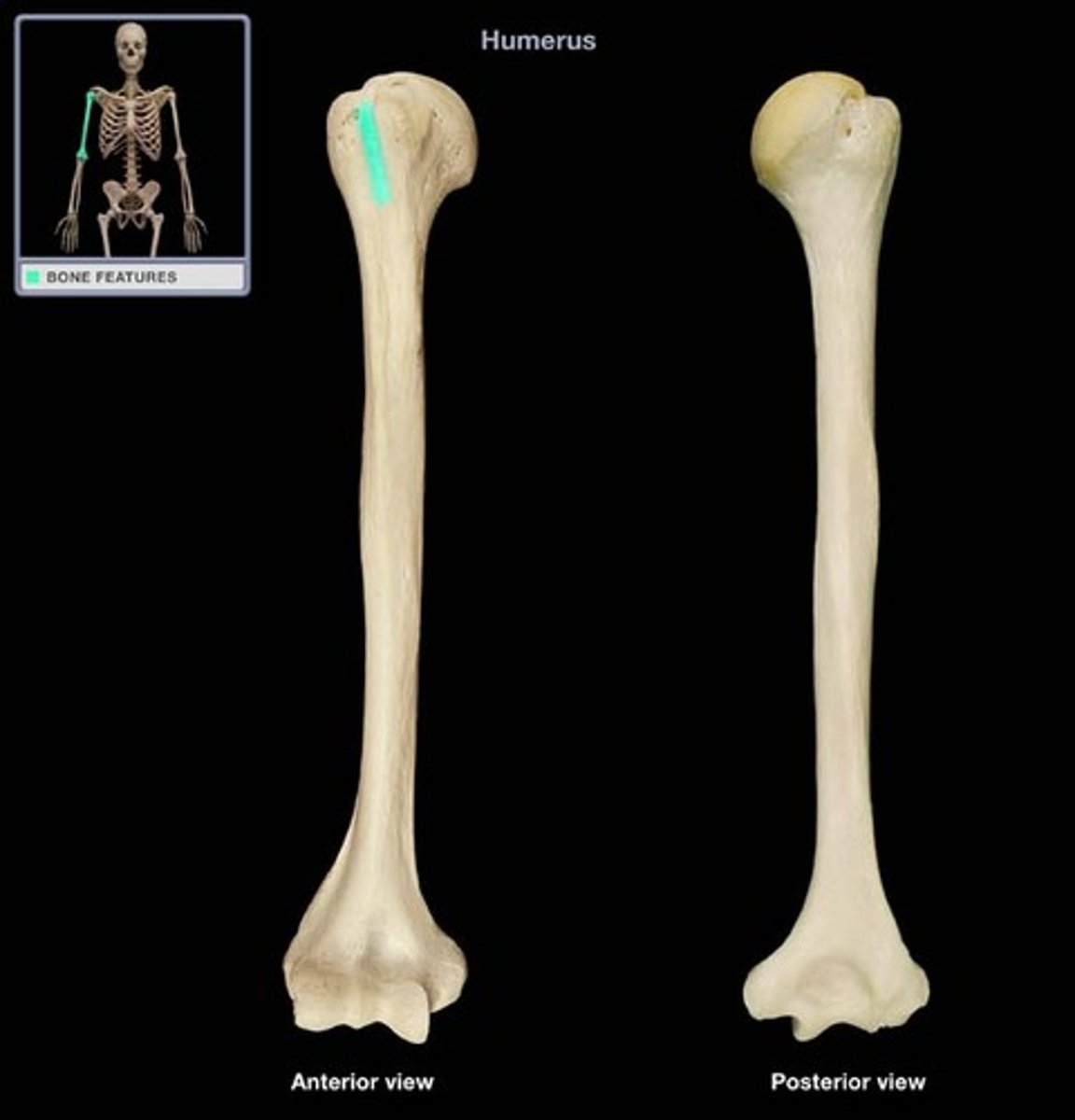
Why would a fracture of the surgical neck damage the axillary nerve
(Clinical relevance)
The axillary nerve wraps around the surgical neck.
-The integrity of this nerve is tested by touching the deltoid since the nerve provides sensory innervation to this area of the shoulder region.
humerus shaft
long portion of the humerus with a tuberosity and a groove, engrossing distally
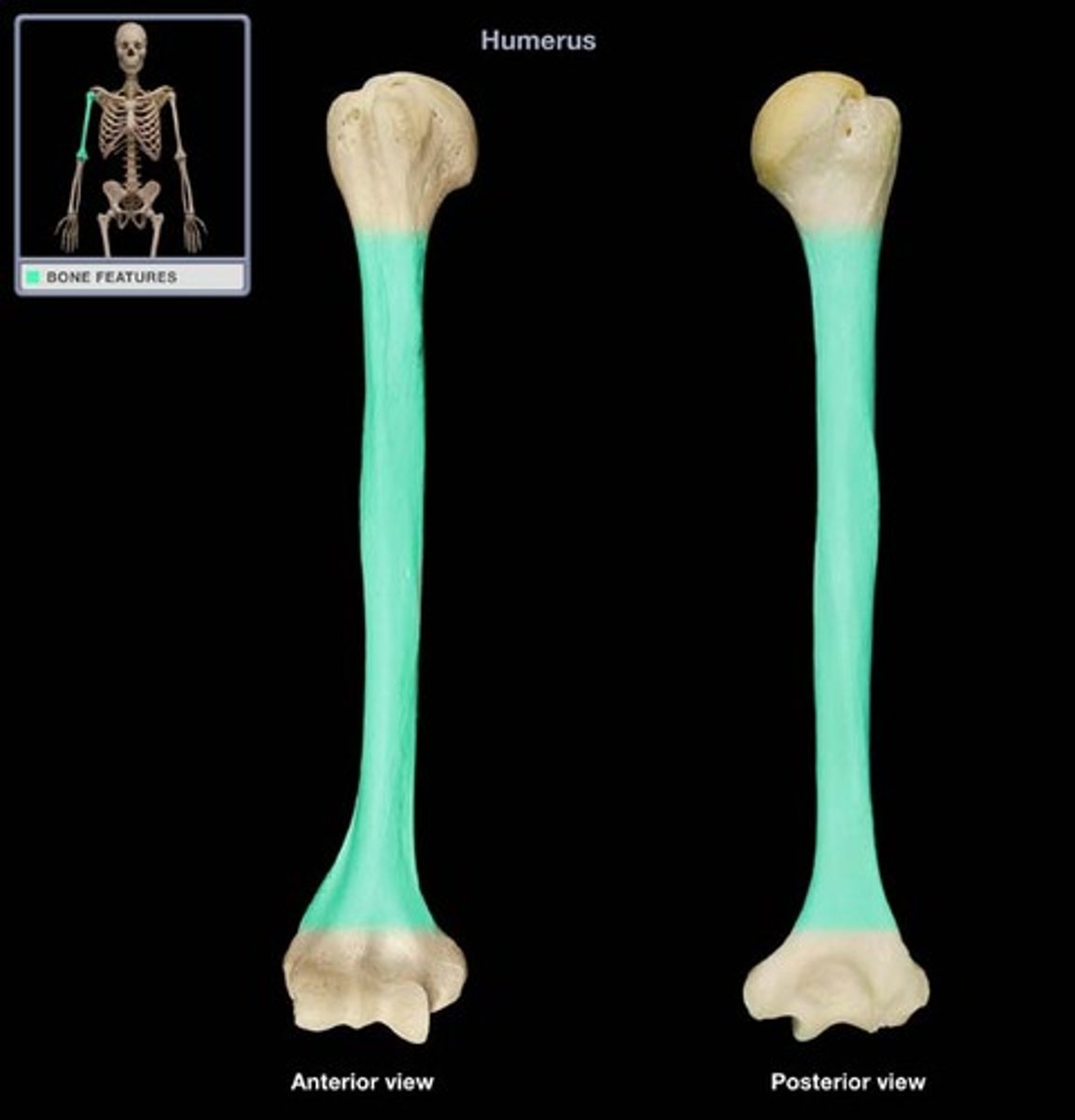
humerus deltoid tuberosity
attachment for deltoid muscle
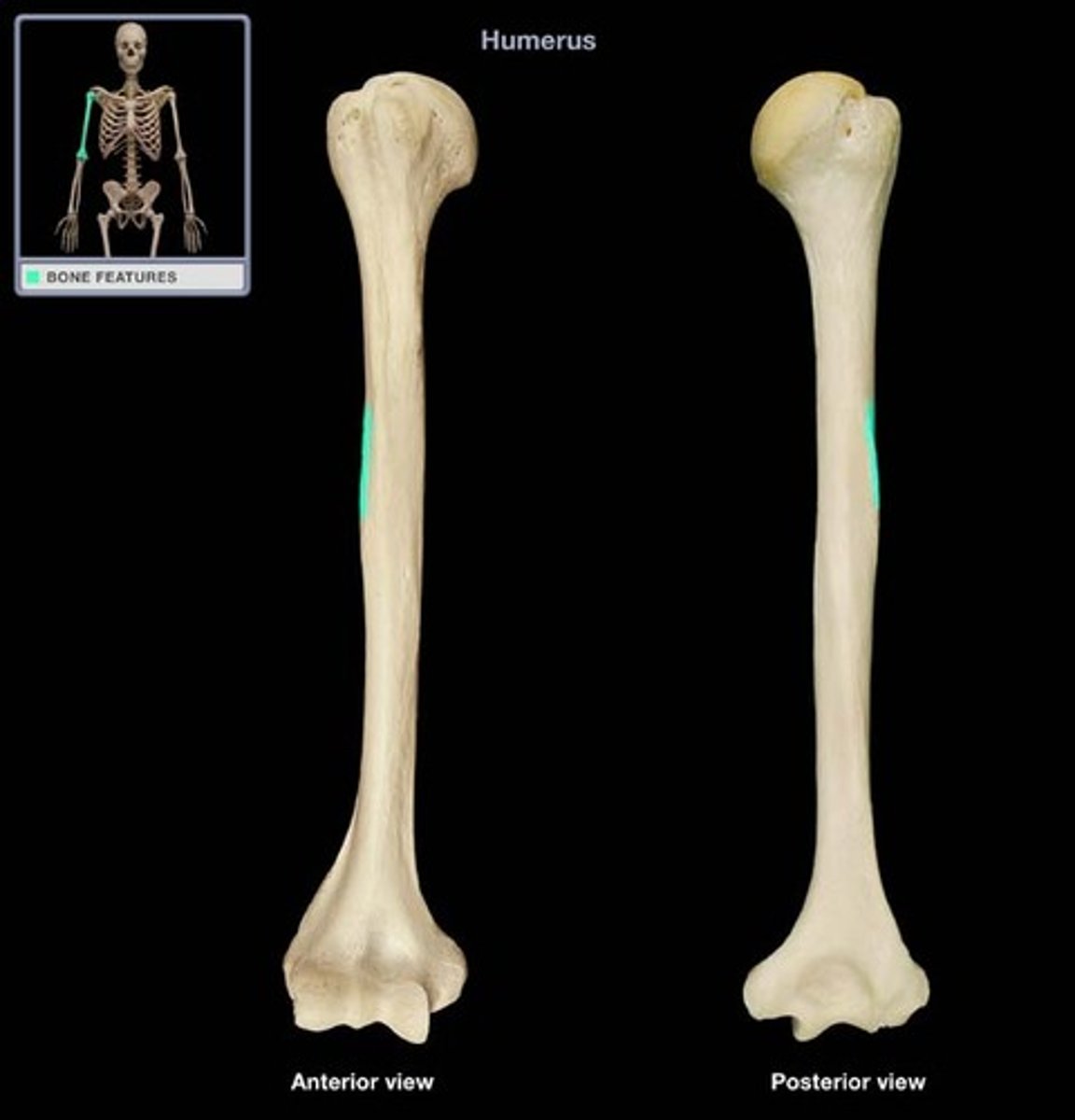
humerus radial groove
oblique demarcation on posterior side. Contains the radial nerve and deep artery of arm
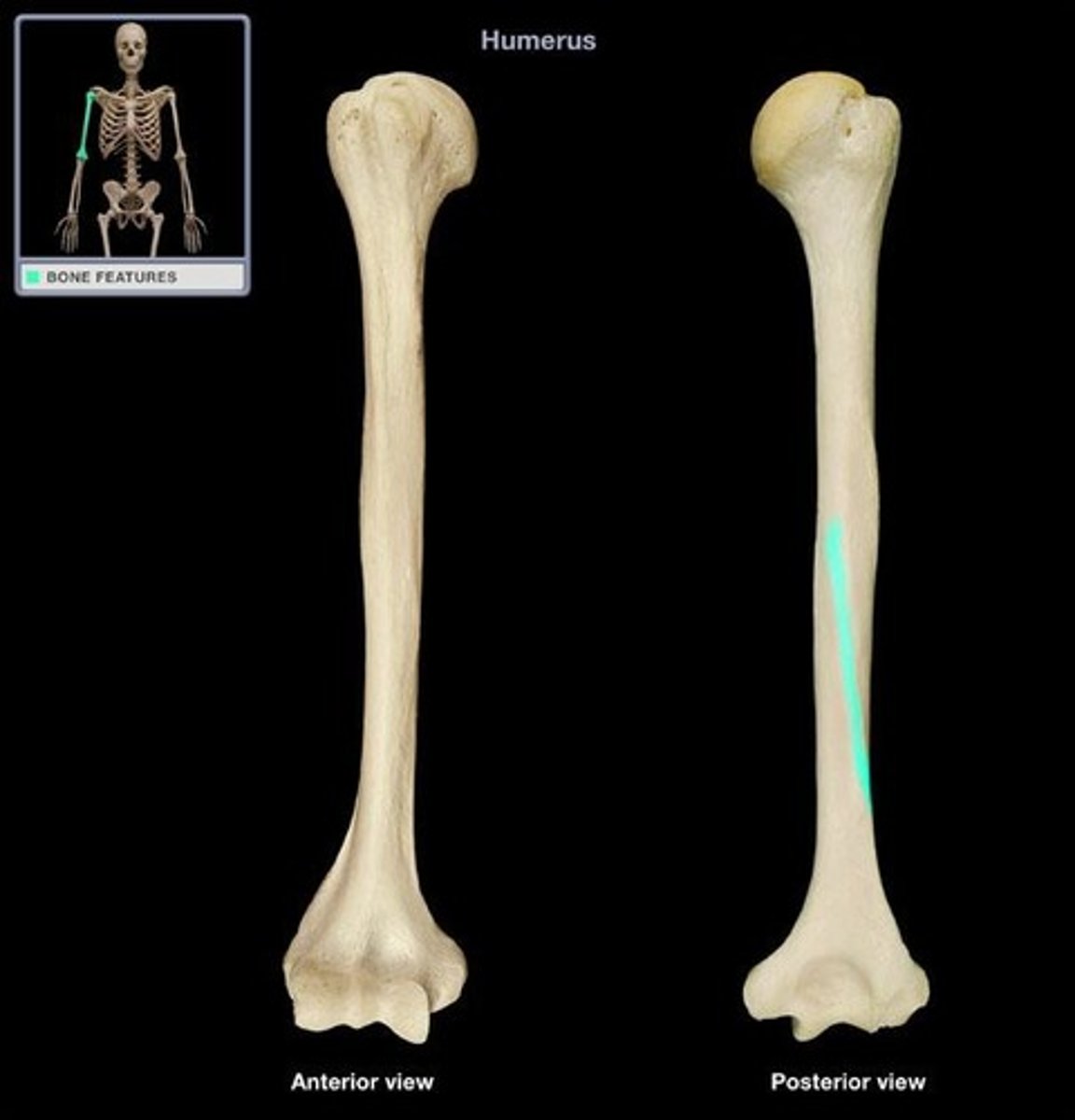
humerus medial and lateral supra-epicondylar ridges
end distally as the medial and lateral epicondyles, involved in muscle attachment
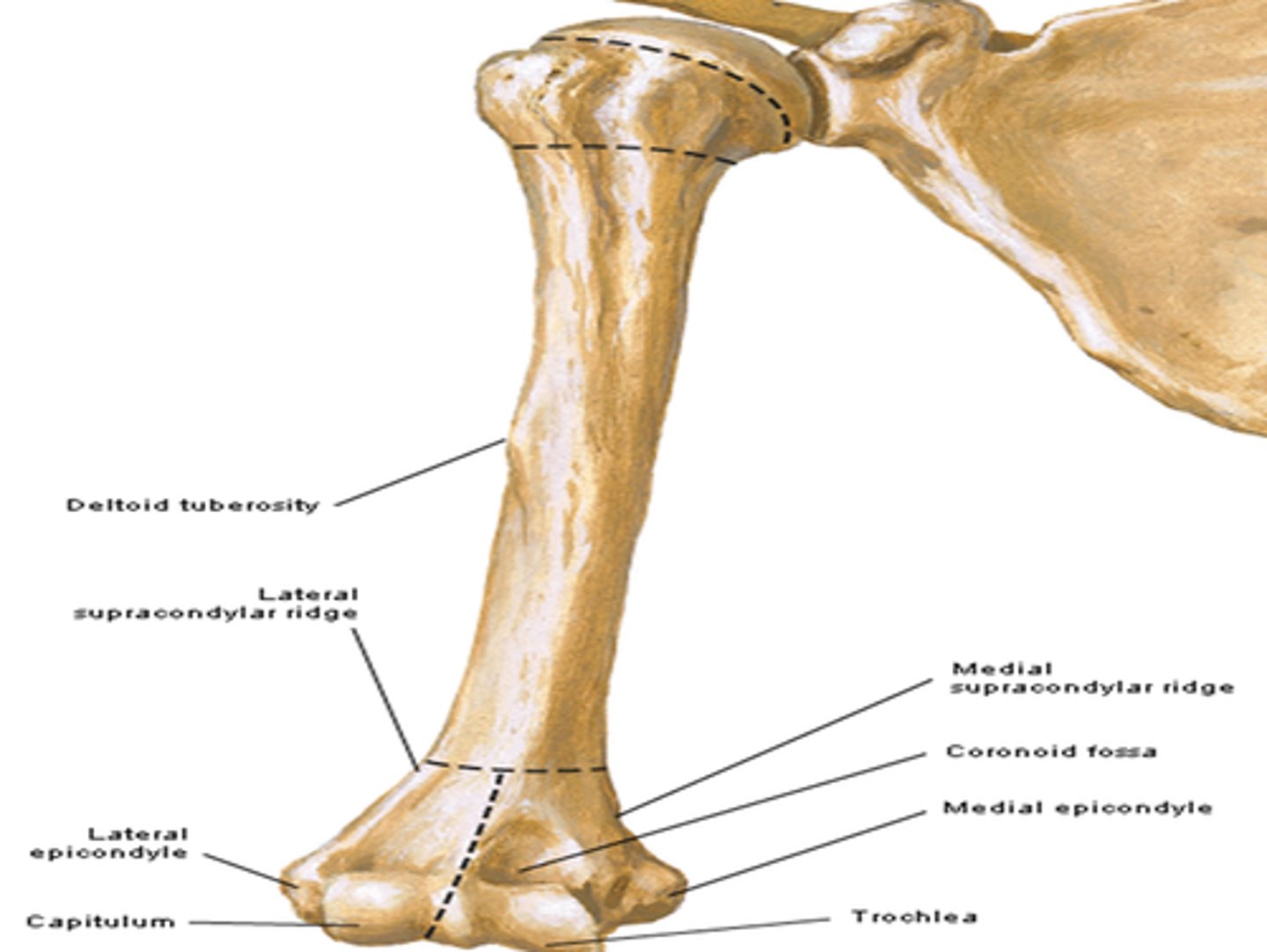
humerus condyle
distal end of humerus that includes the trochlea, capitulum, olecranon, coronoid and radial fossa

humerus capitulum
lateral articular surface. Articulate with head of radius

humerus trochlea
medial articular surface. Articulate with the ulna

humerus coronoid fossa
anteriorly located, receives coronoid process of ulna during flexion of elbow
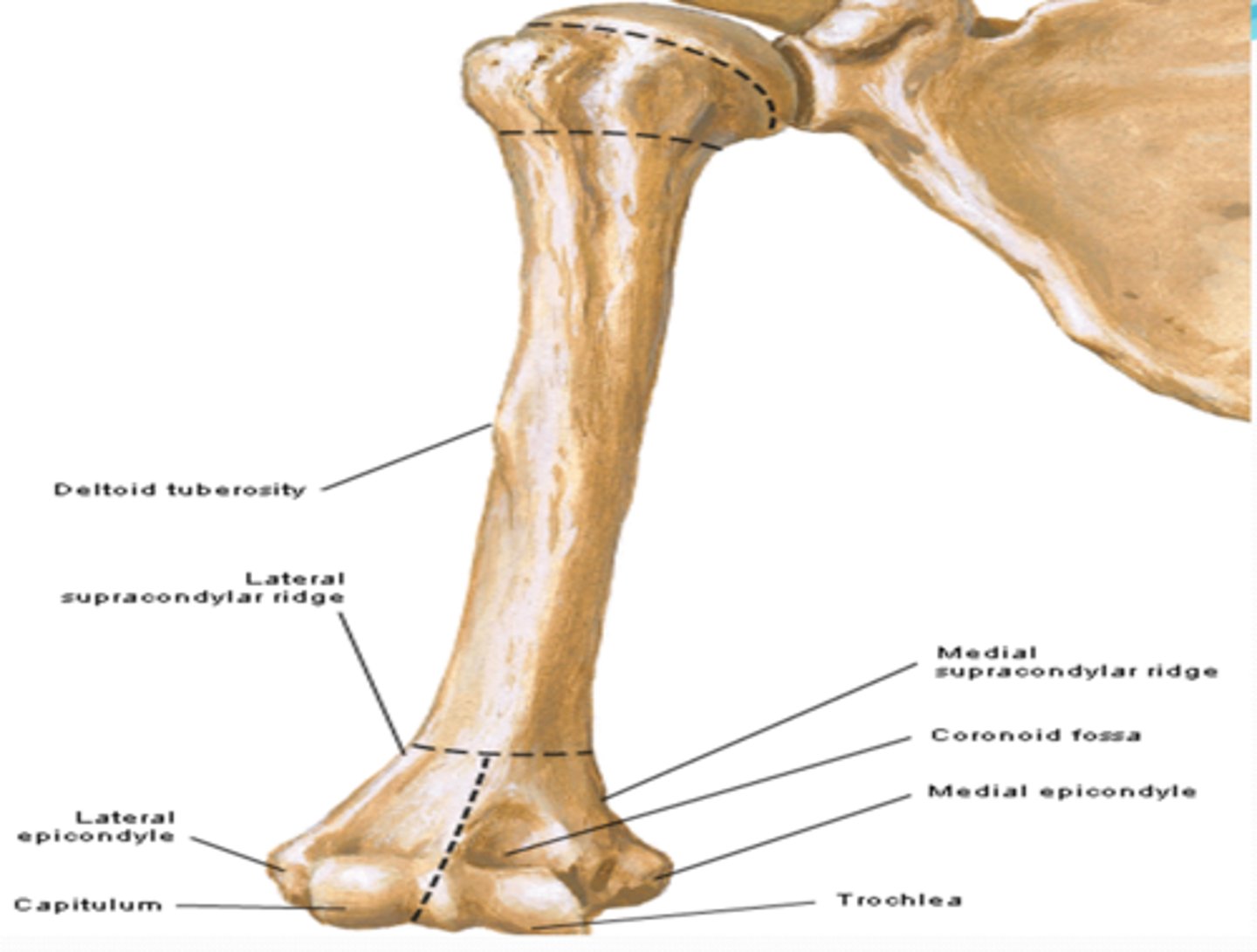
humerus olecranon fossa
posteriorly located, receives the olecranon of ulna during extension

Flexor muscles are going to attach to the
medial epicondyle (golfer's elbow)
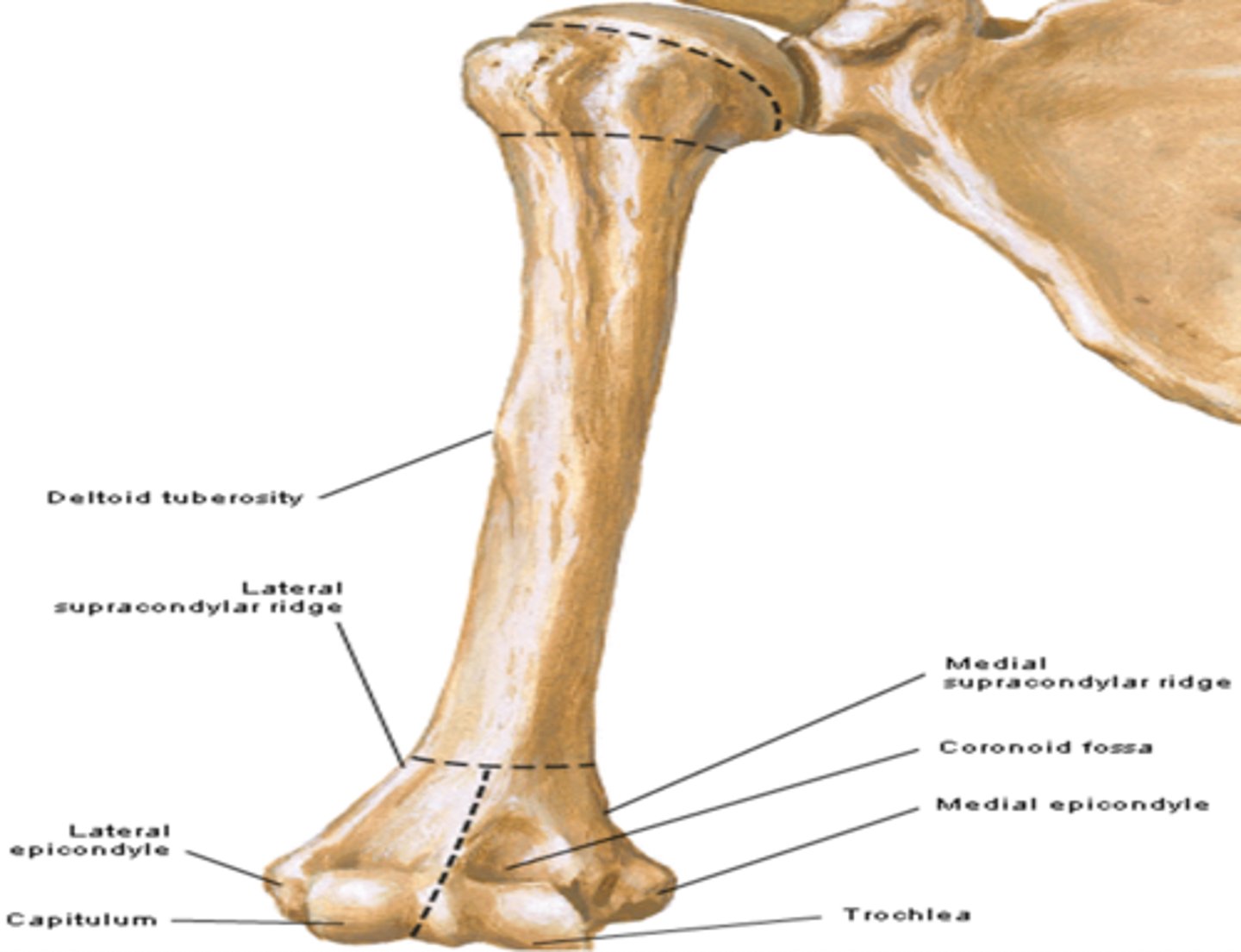
extensor muscles are going to attach to the
lateral epicondyle (tennis elbow)
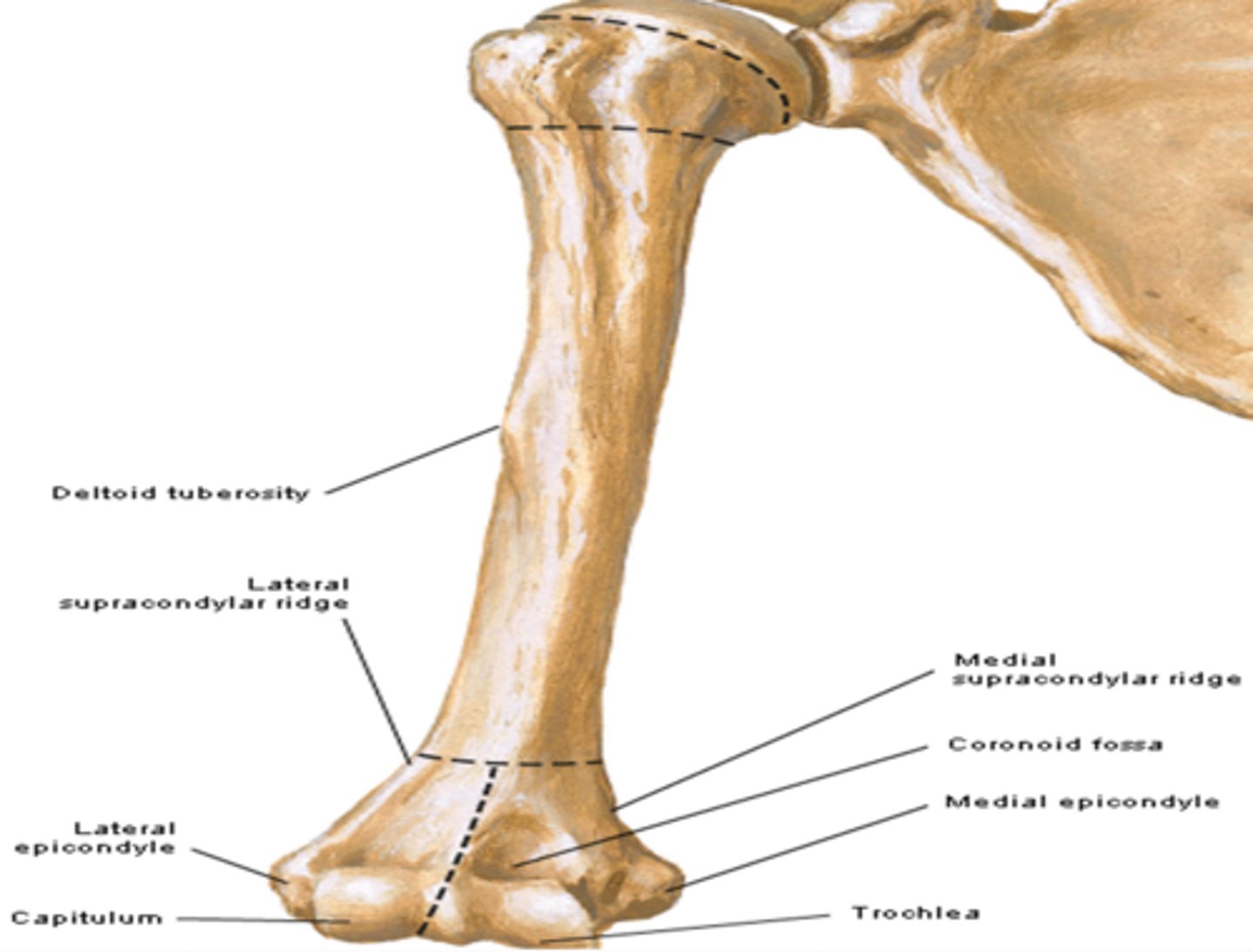
What are the two bones the forearm contains?
radius and ulna

What can the radius do on the ulna?
The radius can pivot on the ulna (suspination and protination) because of their parallel position.
The ulna stabilizes
the bone of the forearm
The location of the Ulna is ...
medial and longer of the two forearm bones
The ulna's articulation is
proximal end (more bulky) with humerus and head of radius. Does NOT form wrist distally
ulna parts
-Olecranon
-Coronoid process
-Ulnar tuberosity
-Radial notch
-Shaft
-Head of ulna
-Ulnar styloid process
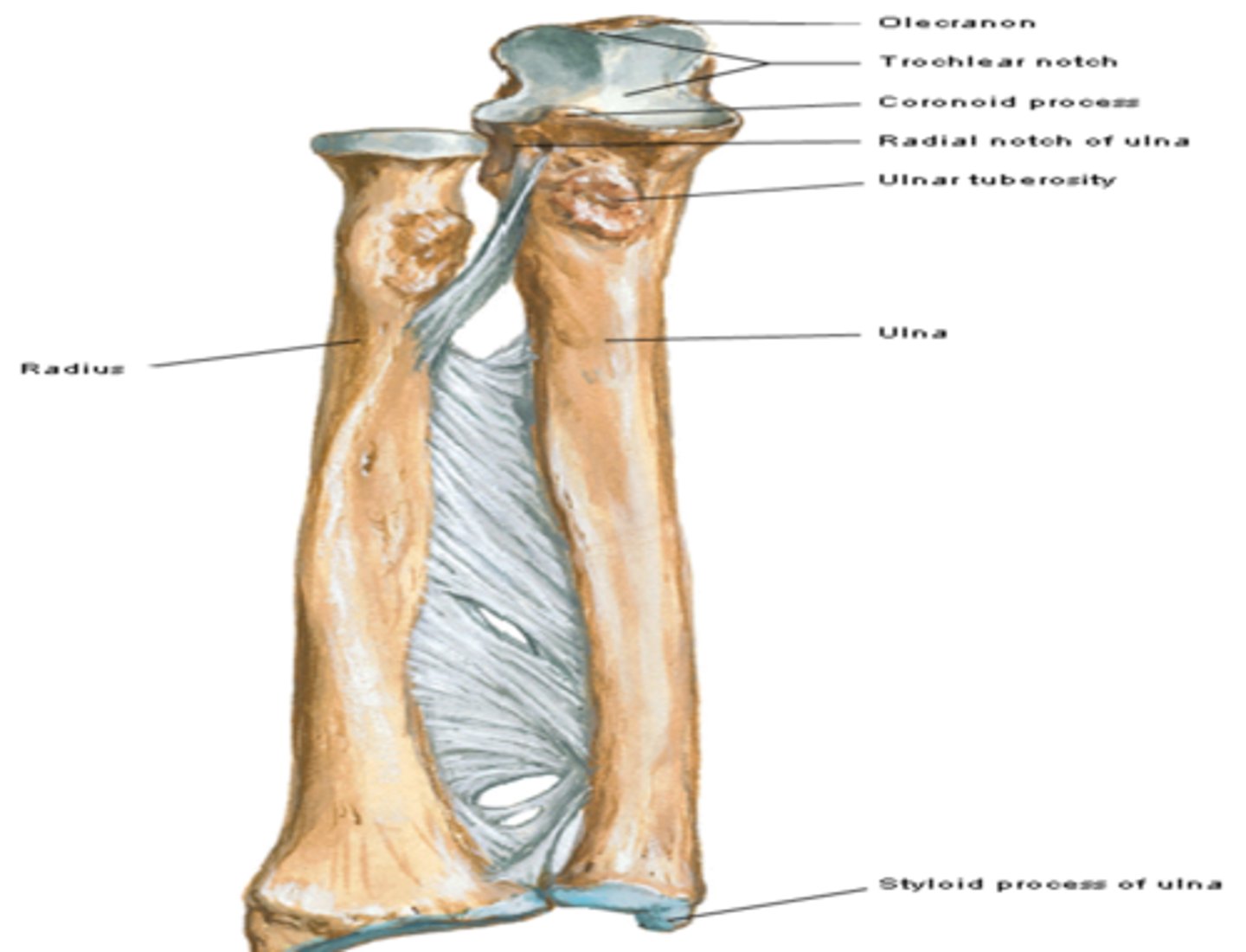
Ulna: Olecranon
superior, most proximal portion. Articulates with olecranon fossa of humerus and serves as a short lever for extension of the elbow
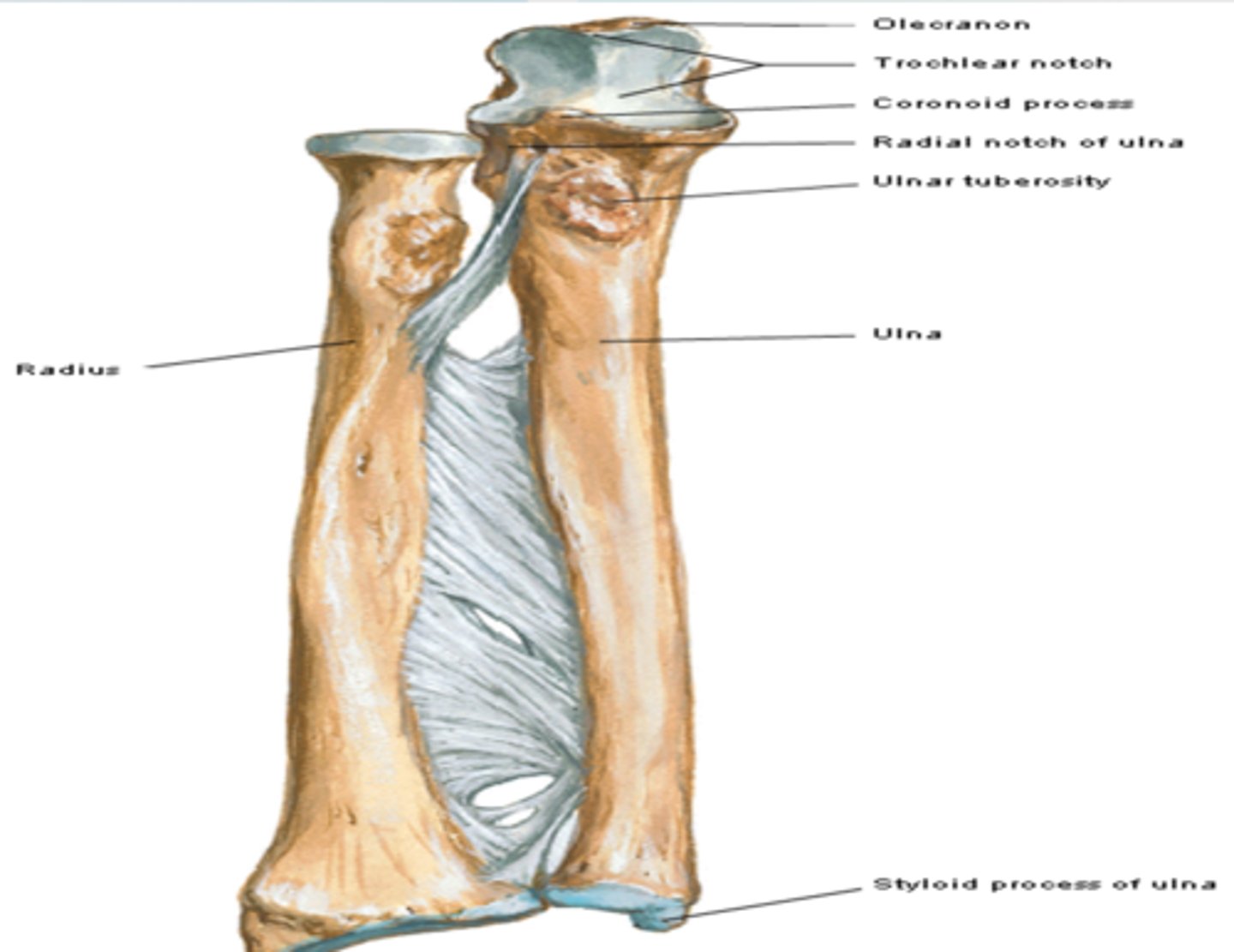
Ulna: Coronoid Process
inferior to olecranon process. Articulates with coronoid fossa of humerus on its anterior side
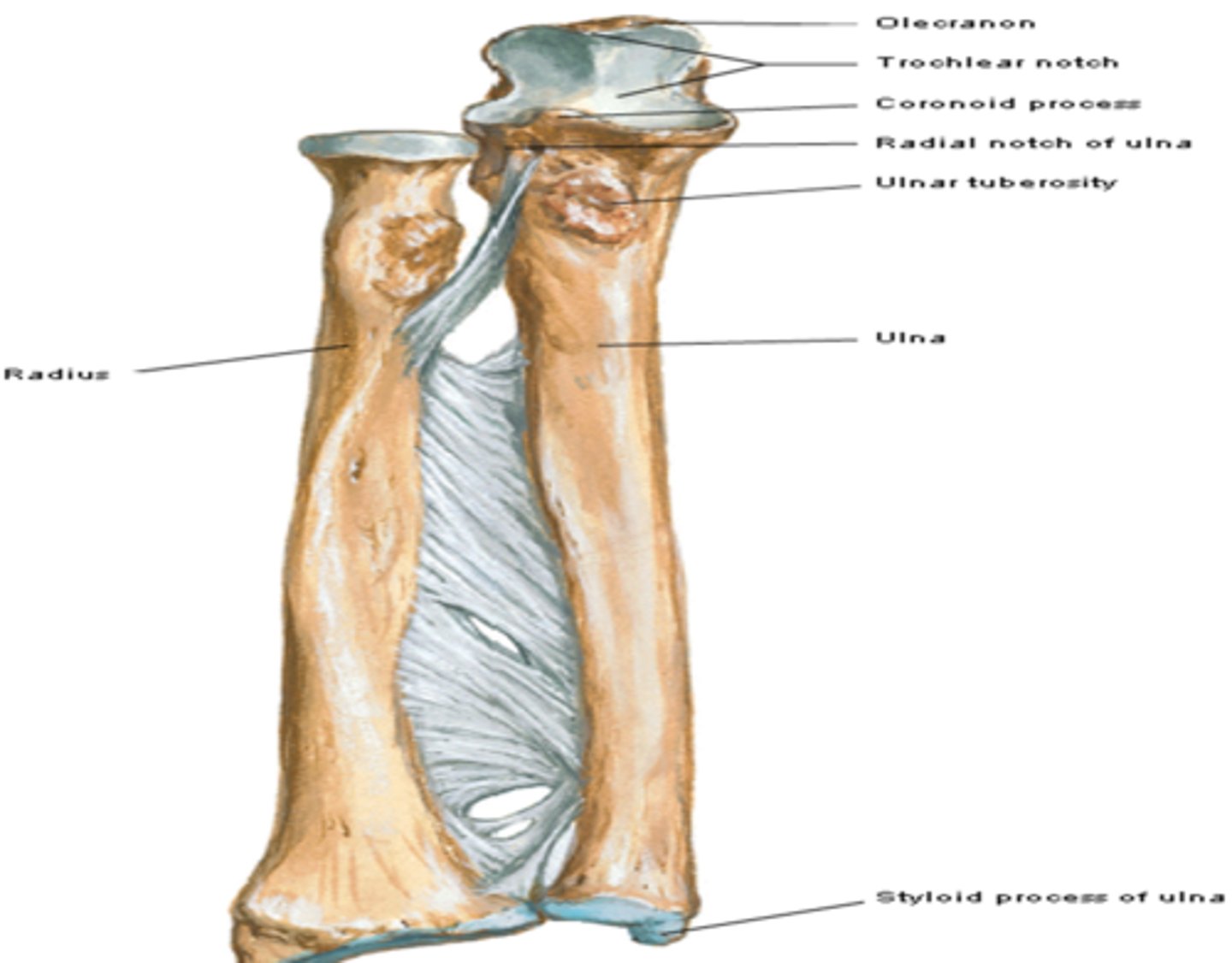
Ulna: Ulnar Tuberosity
attachment for brachialis muscle
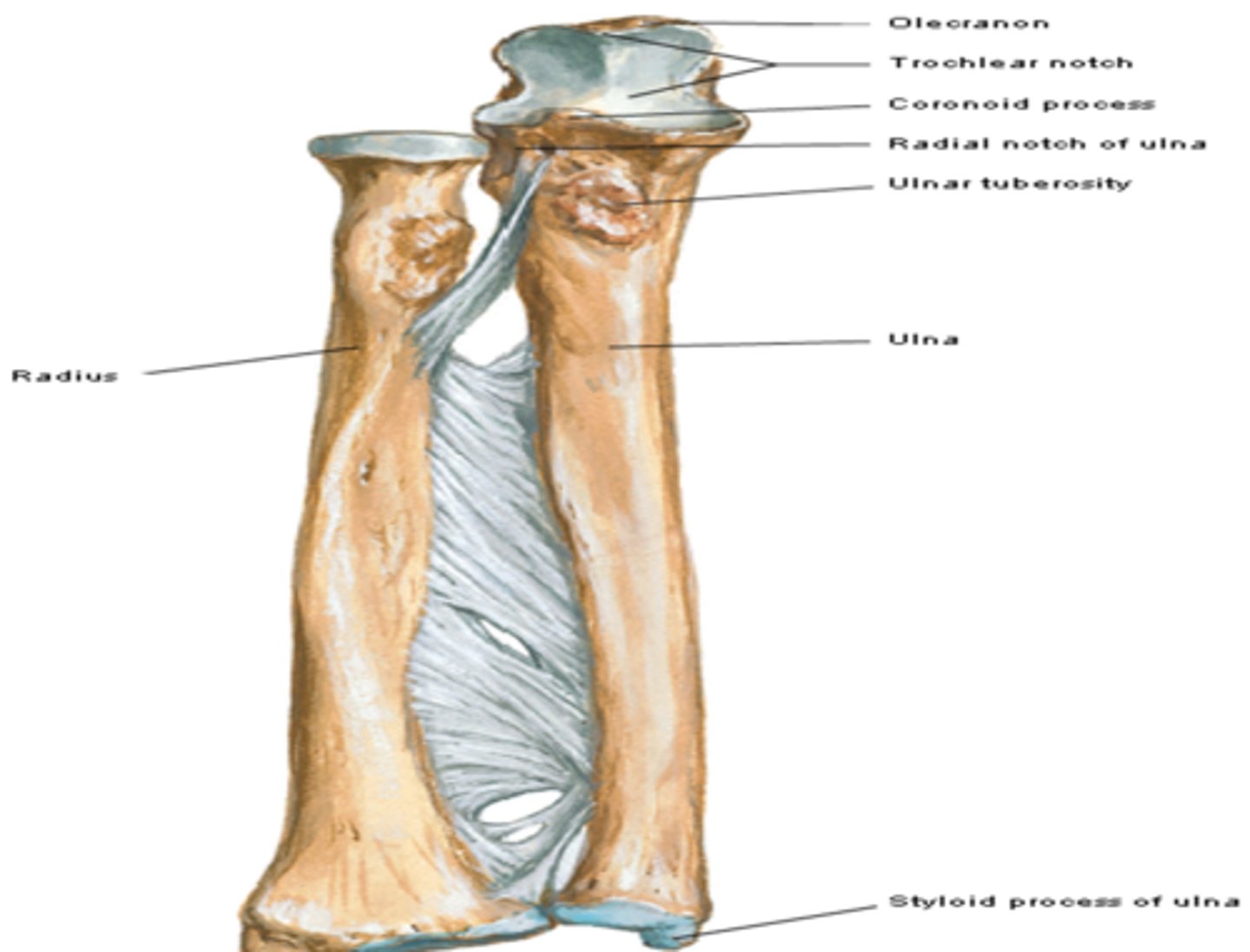
Ulna: Radial Notch
infero-lateral to the coronoid process, receives the head of the radius
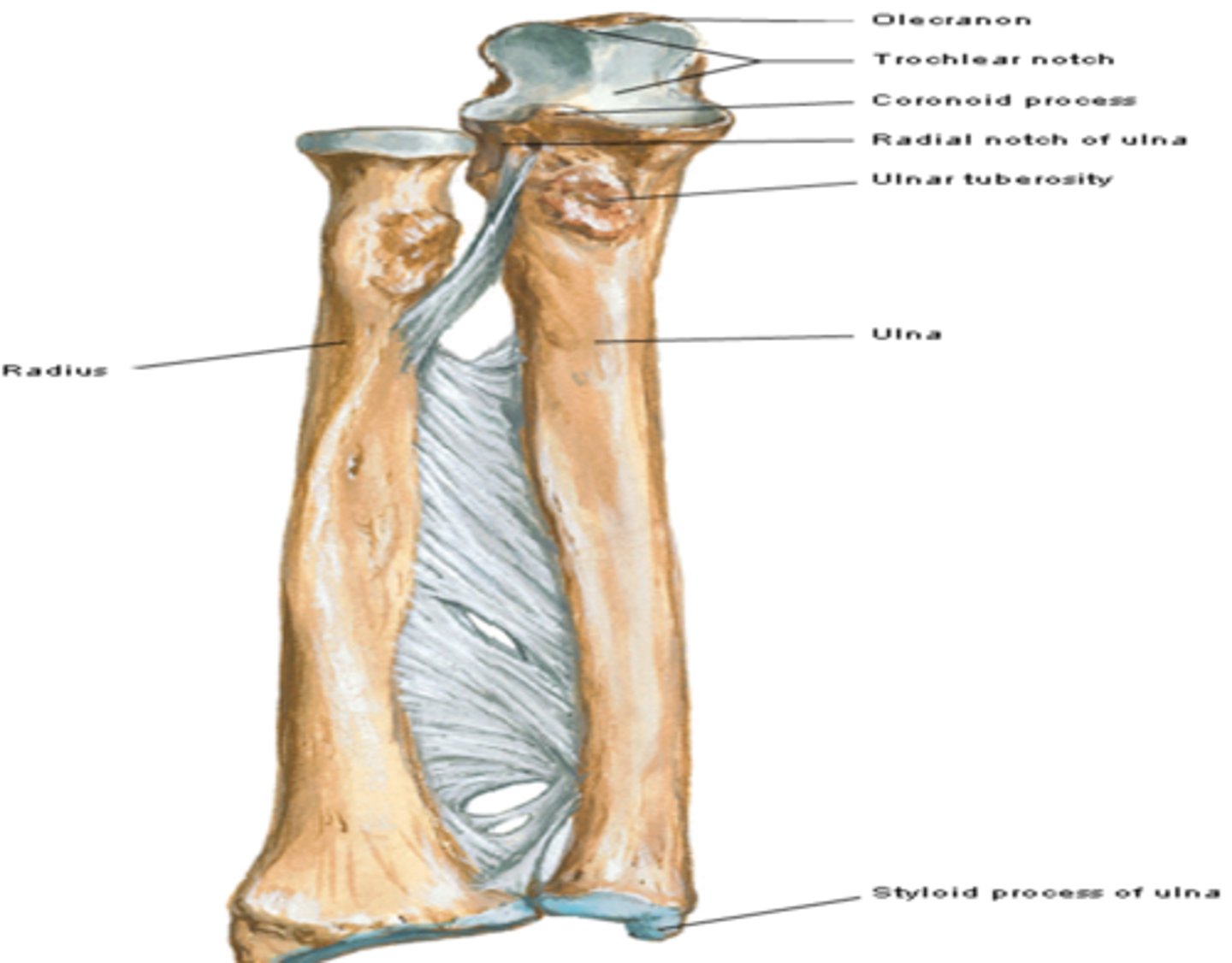
Ulna: Shaft
gets thinner distally
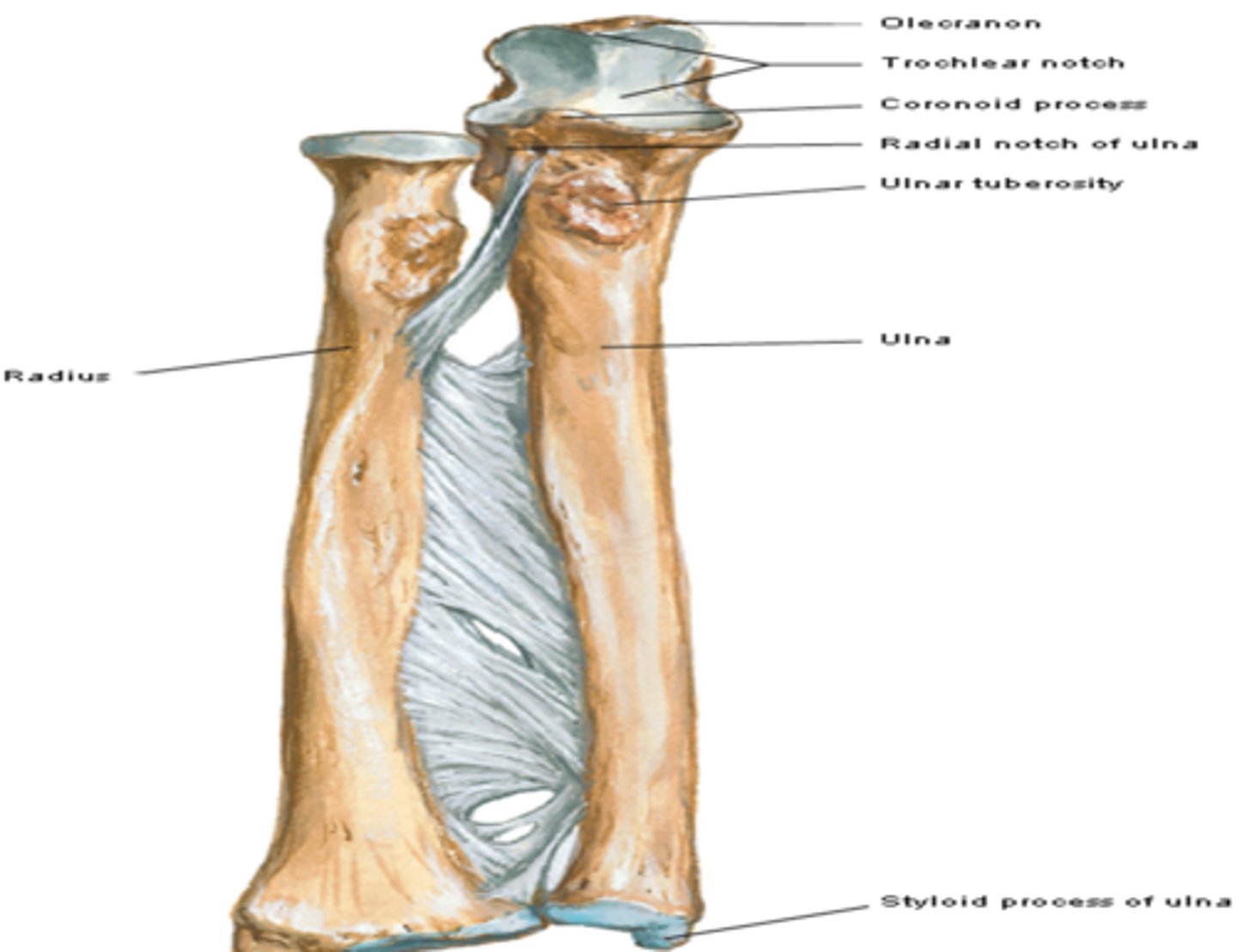
Ulna: Head of Ulna
enlargement on distal part of the shaft
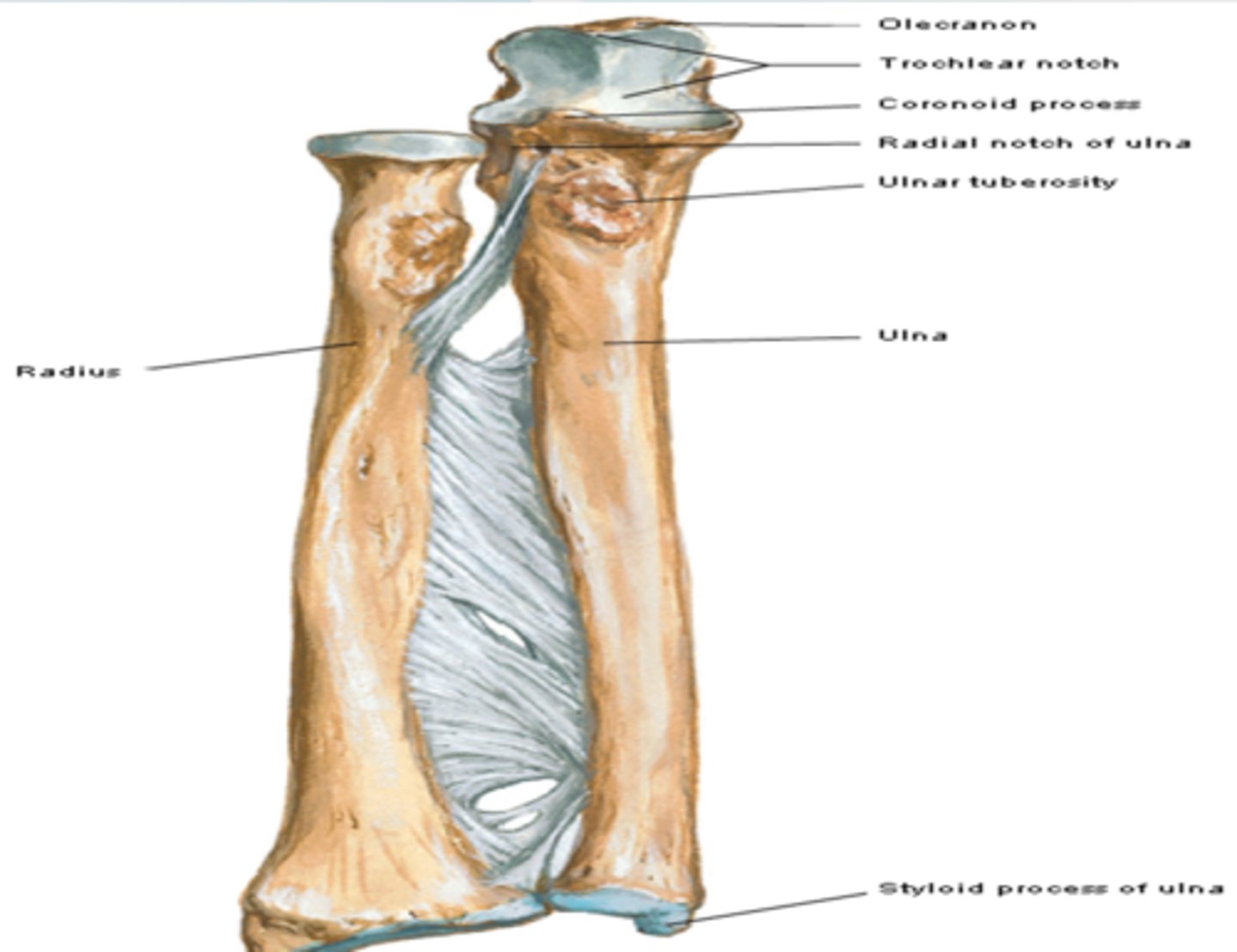
Ulna: Ulnar Styloid Process
distal ending of the head of the ulna

The radius is located in the
lateral and shorter of the forearm bones
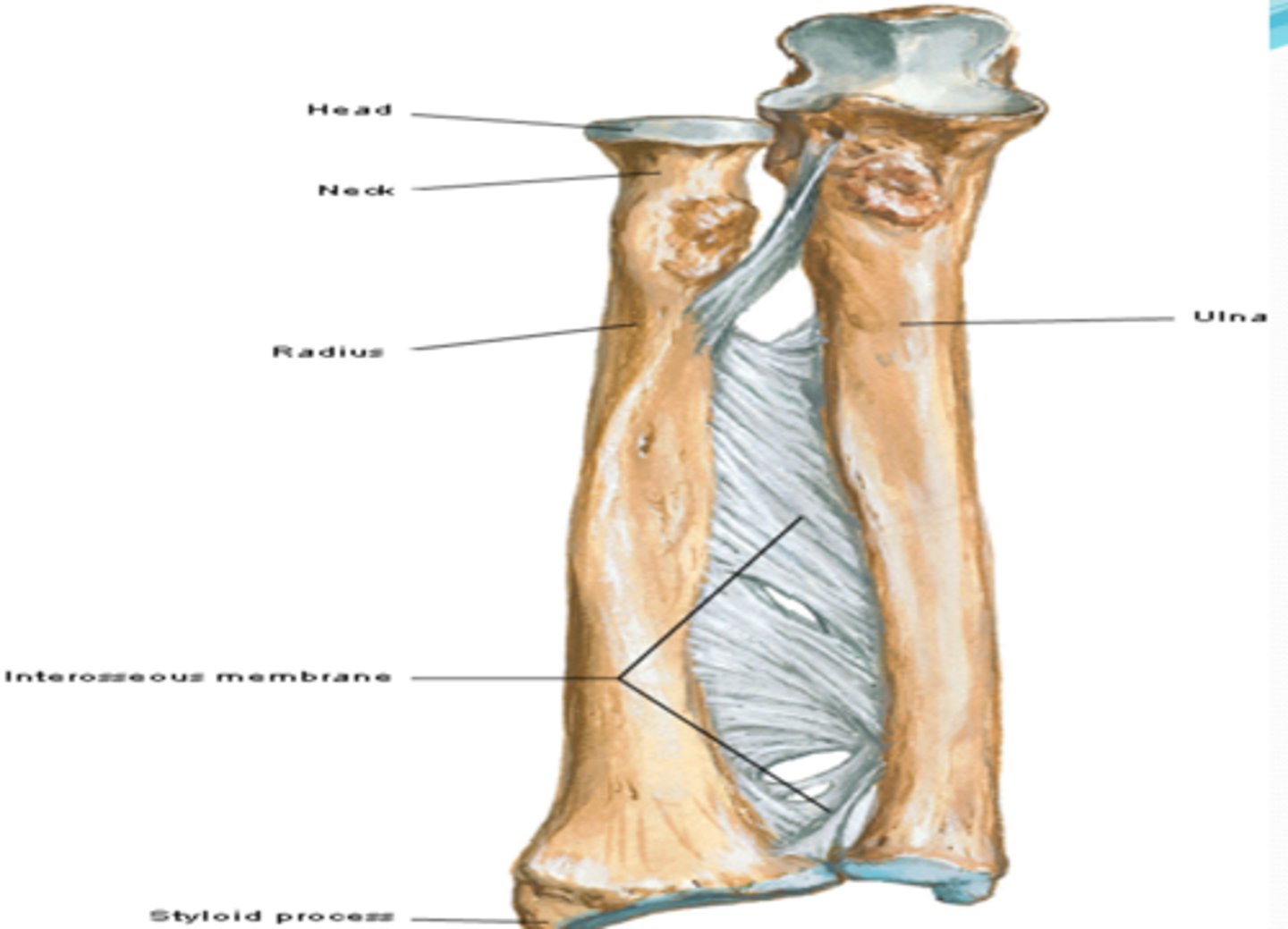
The radius articulates
ulna (proximally and distally). Carpal bones: on the distal side of radius. Radius forms the wrist joint and articulates with the carpal bones.
Radius controls
supination and pronation
radius parts
Head, neck, shaft, ulnar notch, radial styloid process
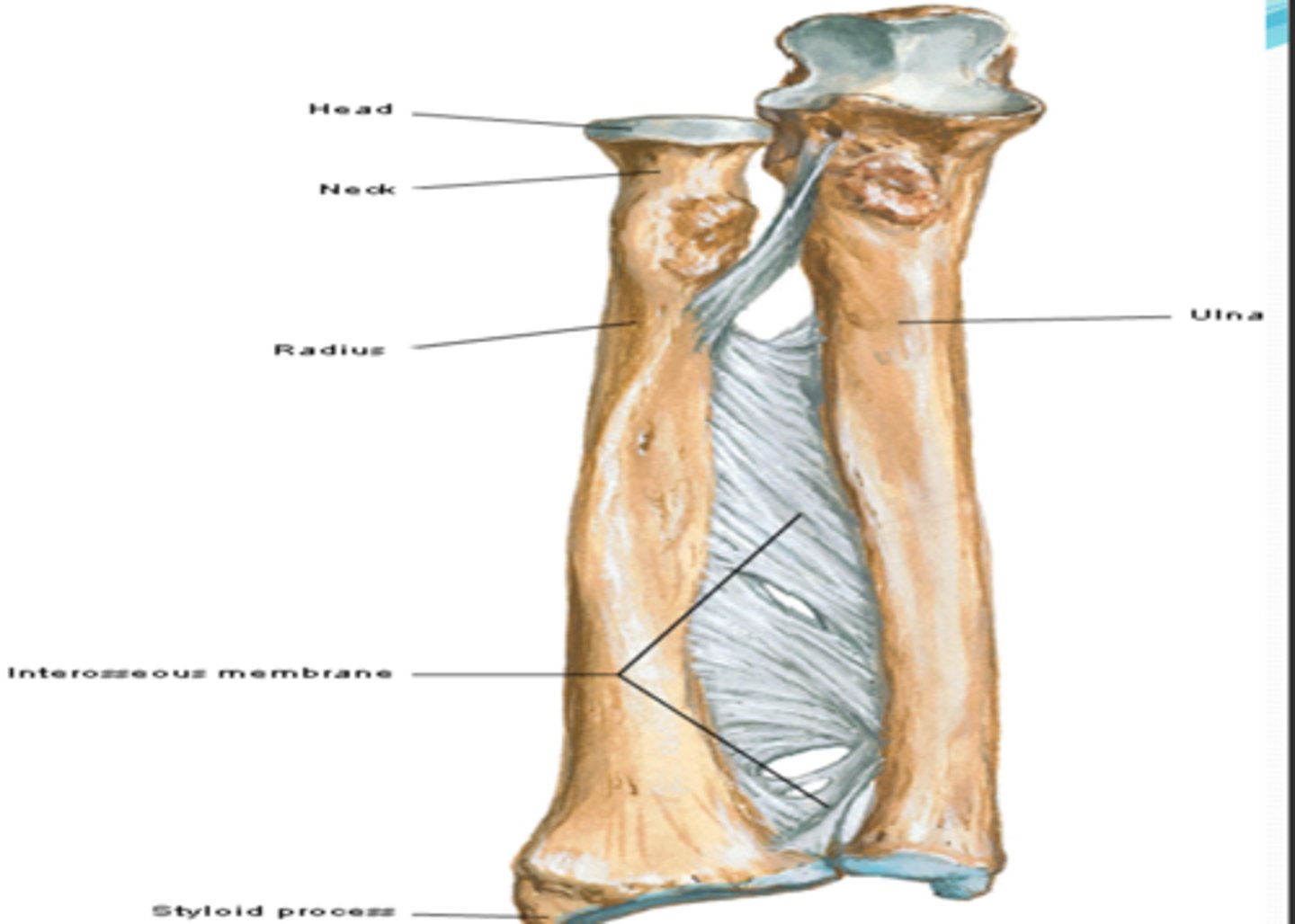
Radius: Head
articulates with the capitulum of humerus and with radial notch of ulna

Radius: Neck
inferior to head

Radius: Shaft
gets thicker distally, opposite to ulna

Radius: Ulnar notch
articulates with the head of the ulna
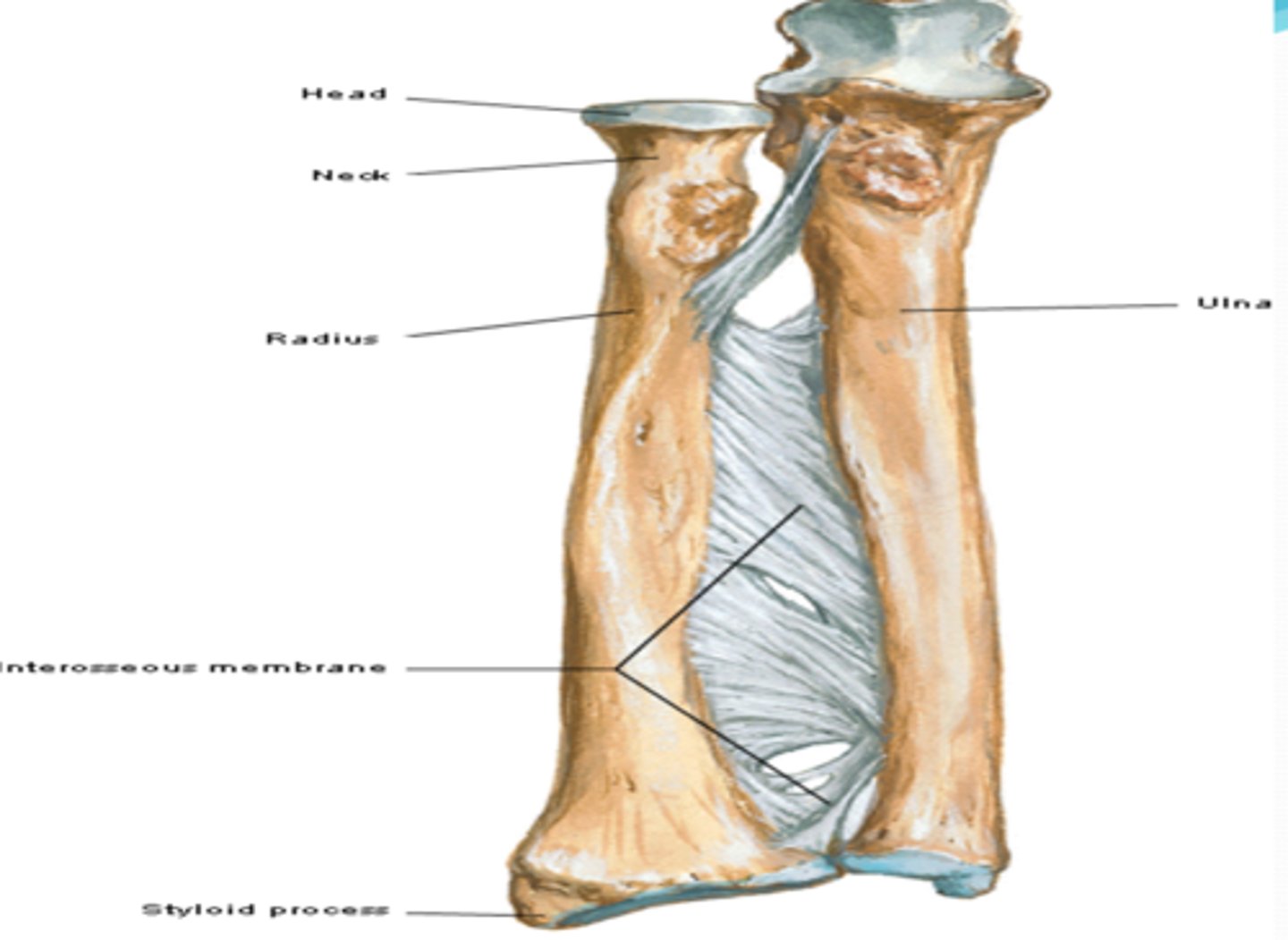
Radius: Radial styloid process
distal ending on lateral side of the shaft of radius
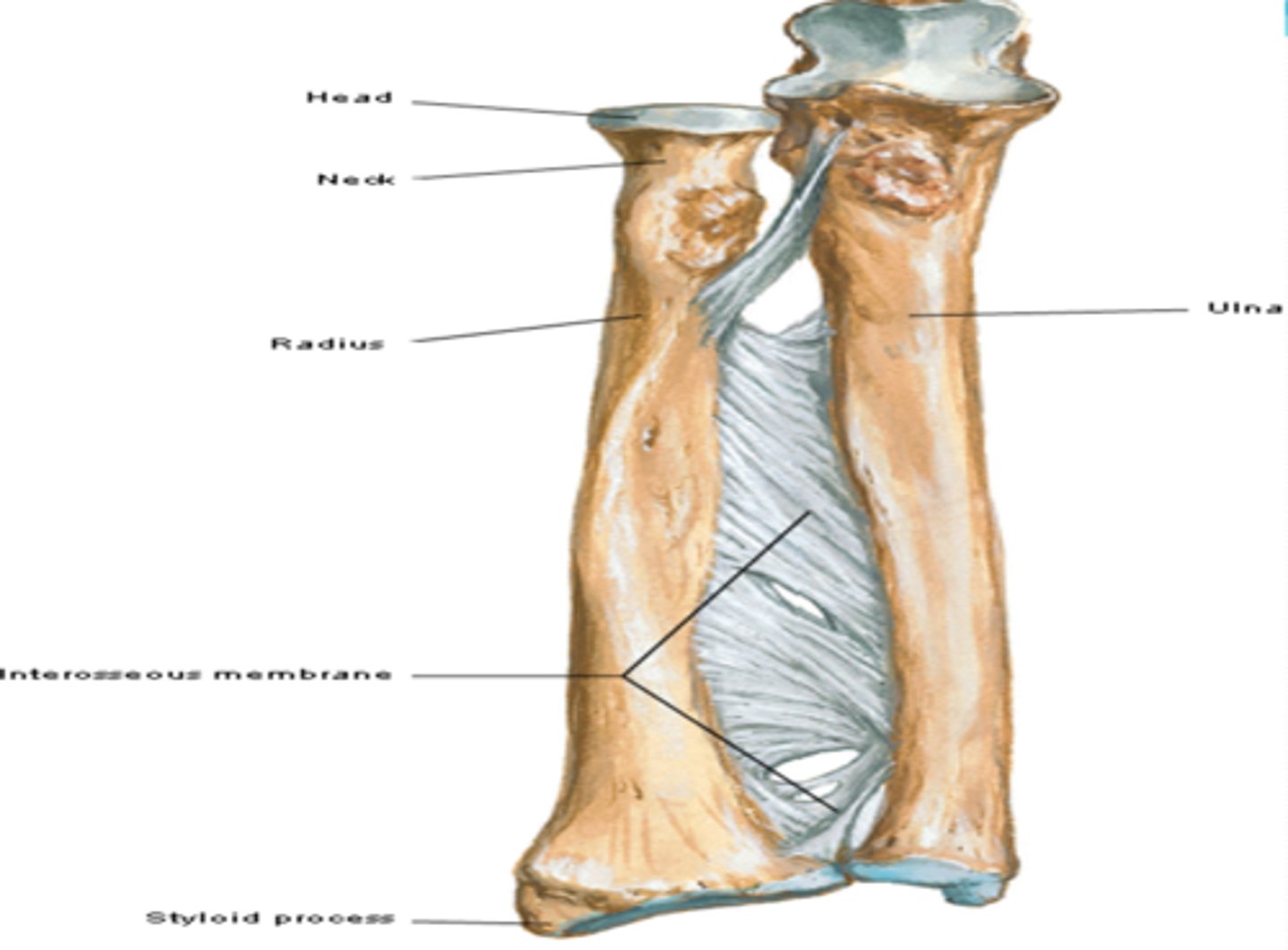
interosseous membrane
thin fibrous membrane, with oblique fibers running inferiorly and medially from the radius to the ulna

Bones on hand: The wrist (or carpus)
Composed of 8 carpal bones arranged in proximal and distal rows of 4
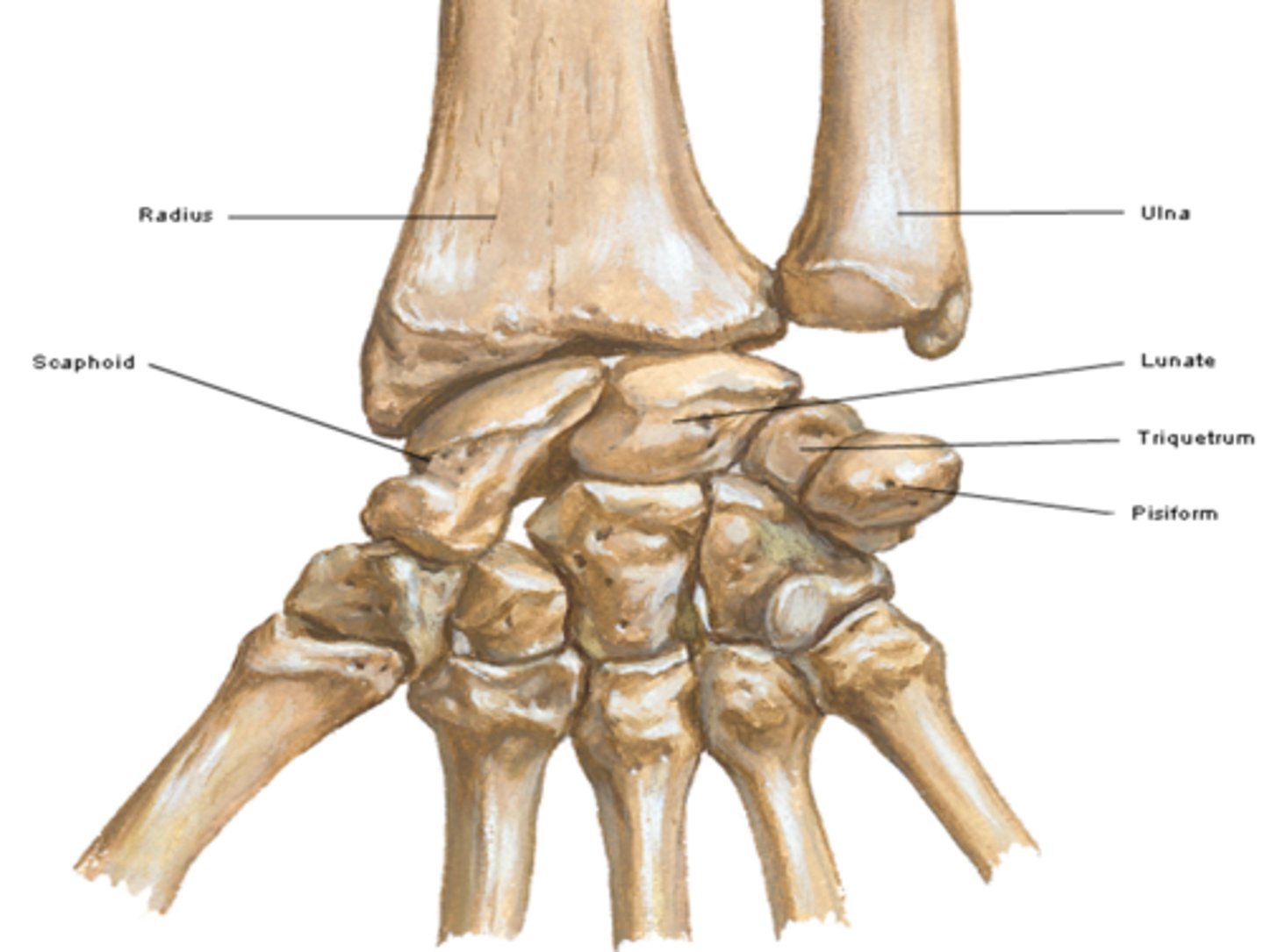
The wrist (carpus) give flexibility
the wrist, each bone glide on the adjacent to it
Wrist (carpus) convex how? and concave how?
convex posteriorly and concave anteriorly (from side to side)